But the more I dug into the Oklahoman's archives the more I found. What's presently available to be read in published sources, including any book or book or article selections written about Oklahoma City baseball, doesn't begin to cover the early period of 1902, 1903, and 1904 with any justice at all. Just doing these three seminal years has taken a full month's time of research and writing. In this final form, Part 1 deals only with those periods of time. Later articles will continue the Oklahoma City baseball story but they will be separate articles linked to this one. Part 1 begins with a snapshot of our earliest days but focuses on our 1902 team, the Statehoods (sometimes called the Mets), the 1903 team, the Metropolitans (or Mets), and the 1904 team also named the Mets. Part 2 (or 3 or 4), when written, will cover 1905 through the present day including our longest tenured team, the Indians, the 89ers, and a little about the Redhawks, our present-day team which is apparently about to lose its association as the Texas Rangers AAA club but presumably some other major league team will then associate with the city. Altogether, the articles will describe and present images of to the extent they are available all of the ball parks that Oklahoma City professional teams (i.e., team members contracted for and were paid money over a series of games) have played base ball in our city.
Originally, baseball was not one word but two with emphasis upon the first syllable of each word and a slight but noticeable pause between each word ... base ball, just like Terrance (Terry) Mann's articulation when describing base ball when talking to Ray in Field of Dreams, above ... base {pause} ball.
Whether you're a baseball fan or not, just like Mann said to Ray in the above audio clip from Field of Dreams, baseball indeed does span America's lifetime and that certainly includes Oklahoma City's part of it. In America, the first game was played in the 1790s; in Oklahoma City the earliest recorded game was July 2, 1889, neither, of course, being considered "professional." It was just played for the fun of it all -- maybe the players got an ad hoc stipend, maybe not. While baseball may no longer be the national pastime, it certainly endures with a gusto in the present day.
Before these articles are done, a decent history of baseball in Oklahoma City will be told and my immodest promise is that they will contain much more information about Oklahoma City baseball than you can find anywhere else on the internet ... perhaps more than you want to read, and this article begins that process.
Before the Oklahoma City part of the baseball party begins, enjoy a few video clips from some of my favorite baseball movies and, ahem, one rock tune inextricably involved with the game. Click the upward arrow in a video's bottom bar for a full screen view. Or, if you want to skip them and go to this article's real content, click here.
| THE NATURAL |
MAJOR LEAGUE I |
| MAJOR LEAGUE II |
| FIELD OF DREAMS |
| MEATLOAF: PARADISE BY THE DASHBOARD LIGHT Leaving the sublime and entering upon the ridiculous, here's one of my all-time favorite tunes ... yes, it's about baseball (inclusion of this video was inspired by my dear friend Joseph, a holy man who likes buzzards and who popped back into my life only yesterday) -- the baseball analogy begins at 3:35 of 8:35 -- Hey, if baseball ain't for fun, what good is it? |
All Rights Reserved, except that permission to reprint, use or distribute
if the above copyright attribution is included is freely granted
NO copyright is claimed as to the above video clips whatsoever
Article Resources Earliest Beginnings Early Ball Parks
Stiles Park & Territorial Fair Grounds Kramer's Park
Colcord Park/Delmar Garden Colcord Park Sportsman's Park
Exchange & Tena Ball Park 1923 Floods
The 1st League Years 1902
1902 Team/League Attempts 1902 Games 1902 Attendance
1903 1903 Games What Happened to Quigg?
1904 1904 Summary The God Problem Importance of Sunday
Guthrie Enid Oklahoma City
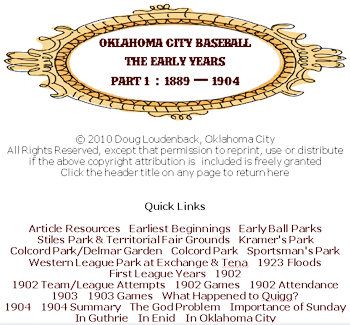 This file is also available in PDF format for any that want it. The PDF version is 37 pages long, is bookmarked, and is much better for printing. The PDF version does not include the above videos.
This file is also available in PDF format for any that want it. The PDF version is 37 pages long, is bookmarked, and is much better for printing. The PDF version does not include the above videos.For those who want to save the article to their computer, or print it, use of the PDF file is highly recommended. To open the PDF file, left-click here. To save the file to your computer, right-click on the same link and, in Firefox, select "Save Link As ..." from the pop-up menu; in IE Explorer, select "Save Target As ...". Either way, identify the location on your computer that you want to the PDF file to be saved to when you are prompted to do so.
RESOURCES FOR THESE ARTICLES. Some sources I'll just identify "as I write" but three deserve to be singled out for special attention.
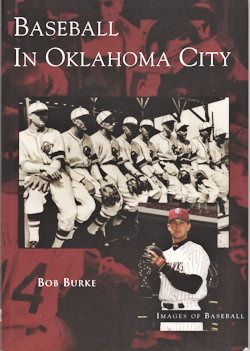 Bob Burke's Baseball In Oklahoma City (Arcadia Publishing 2003). In this Arcadia "Images of Baseball" 128-page publication, Bob Burke presents Oklahoma City's baseball history through 2003. If you don't find the book at local booksellers, it can be ordered at Amazon.com as well as at (I presume) other internet locations. When making a reference to this book, or presenting an image contained within it, the credit will read, "Burke, page xx."
Bob Burke's Baseball In Oklahoma City (Arcadia Publishing 2003). In this Arcadia "Images of Baseball" 128-page publication, Bob Burke presents Oklahoma City's baseball history through 2003. If you don't find the book at local booksellers, it can be ordered at Amazon.com as well as at (I presume) other internet locations. When making a reference to this book, or presenting an image contained within it, the credit will read, "Burke, page xx."
My only criticism of Burke's book is that it does not explore background and behind the scenes detail particularly closely, but I do understand why that was not done. In this regard and in defense of Burke, Arcadia Publishing Company limits its authors to 128 pages and, within those 128 pages, it rather severely limits the number of literal characters, word by word, page by page, contained in an author's written text. Arcadia's series of books, as delightful as they are to have (and I own many) focuses upon photographs much more than they do a historian's written text, the written word. While Arcadia's process may generate sales, and that is good, it does not generate scholarship, and that is bad. Arcadia knows that pictures sell books ... and we're all glad to have them ... but this note may explain the lack of historical depth/development contained in the Arcadia books that we have in our bookstores, including Burke's book as well as my own. What I've just said matches my own personal experience in writing my own Arcadia book, Springlake Amusement Park. Would I like a more scholarly presentation to be possible in Arcadia books? Absolutely. Am I glad that Arcadia has presented multiple series of history books without doing that? Yes. If Arcadia hadn't published its various series of books (Images of America, etc.), probably no other publisher would have done so. In balance, what Arcadia has done with its approach is more of a historical positive than a negative, even if it could have been done a lot better (e.g., reduce the font size so that more text can be presented and reduce the number of photos required for a book's publication). History lovers would love both suggestions, I think.- Roy P. Stewart's Born Grown (Fidelity Bank 1974). Although Stewart's book doesn't talk a whole lot about baseball, the 1st 3 pages of Chapter 9 (in very small print) traces the early-day history rather well from a overview perspective. In comparing parts of Burke's text with Roy P. Stewart's 1974 Born Grown, it seems likely that Born Grown was a source of much of Burke's early-day baseball description even if Stewart's book was not credited. When making a reference to this book, or presenting an image contained within it, the credit will read, "Stewart, page xx."
- Oklahoman Archives. Not to complain, but neither of the above sources very often presents the nitty-gritty, the stories behind the stories such as the fight that almost broke out when the Oklahoma City Metropolitans were playing in the Southwestern League on the Enid Evangelist's home turf in July 1908, and the like. For anecdotal stories of that type, the Oklahoman's on-line archives from September 1901 through the present day provide an invaluable source of information. If this article has an original contribution to make, it is in the collecting and presenting of historical and anecdotal information gleaned from the Oklahoman's on-line archives. These references will be referenced as "Oklahoman, [date]."
Although professional baseball did not organize on a sustaining basis until 1904, baseball began in Oklahoma City only a few days after the Run. The first ball park was located just outside the city limits on "Higgin's Forty," west of Walker Avenue, near where the Municipal Building stands today. The "grandstand" was constructed of beer kegs and two by twelves. The kegs were borrowed from a saloon at First and Harvey. One who helped build the stands was 16-year-old Eugene Barnes, who was destined to play a principal role in Oklahoma City baseball for the next thirty years. ¶ The Oklahoma City Browns, one of three teams organized, played a Guthrie team once in Oklahoma City and twice in Guthrie, winning all three games. In addition the city teams played each other. The playing field moved in mid-season in 1889 when Higgins ran the players off. The new location was a block east of the Santa Fe tracks in the military addition. ¶ Baseball was spasmodic during the 1900's, with several unsuccessful attempts at organizing professional teams. The first professional team to play a full and successful season was the Oklahoma City Metropolitans. The Mets played in 1904 under the management of Barnes. Beefed up by the remnants of a Galveston, Texas, team which had deserted in a player strike two years earlier, the Mets won first place in the Southwestern League, an all-Oklahoma circuit.Actually, as you will see in the 1904 section of this paper, Guthrie won the 1904 league pennant, not Oklahoma City, and a case can be made for the proposition that 1902 and 1903 also had sustained professional teams, even if chaos reigned supreme. The same can be said for 1904, as you will see.
Supplementing what Stewart wrote are these additional observations from Burke, page 9:
Baseball was the sport of choice of Oklahoma Cityans from the beginning. Within days after the prairie was opened to homesteaders, Sunday afternoon baseball games were organized. Soon, teams from Oklahoma City began competing with teams from surrounding towns. * * * ¶ The first organized team in Oklahoma City was sponsored by Walter and Harry Jennison in May of 1891. They built a wooden backstop and a new ballpark between Grand Boulevard, and California, Walker and Dewey Avenues. The Jennisons' team was called the Pirates -- they played their first game on June 19, 1891 against the Purcell Chickasaws. To entice fans to the game, Walter Jennison distributed a flier about town announcing that admission was free and that ladies were especially invited. To allay fears about bad influences at the game, the flier said drinking would not be allowed and betting and prostitution were "absolutely" forbidden on the grounds. ¶ Townball, or town baseball, became an institution in the 1890s in the cities and towns around Oklahoma City. Many businesses sponsored teams that played before sprawling crowds of hundreds dressed in their finest at Sunday afternoon games. Baseball historian Charles Saulsberry called the years 1895 to 1900 "the expansion era" for baseball teams in central Oklahoma. * * * ¶ By the beginning of the twentieth century, Oklahoma City fans were aware of the growing stature of baseball as the national pastime. Around hot stoves in winter and under shade trees in summer, talk began about Oklahoma City having its own professional baseball team.THE EARLY BALL PARKS. When our city was born on April 22, 1889, baseball was already part of the American fabric. Aside from the land-runners just surviving, staking out homesteads, building two-story frame buildings on Main Street, etc., one of the 1st things that some (and I don't presently know who) did was to construct a baseball park just as quickly as the land-runners constructed churches, if not before. Obviously to the land-runners, baseball was just as important.
Stiles Park & A Temporary Ball Park At The Territorial Fair Grounds. I'm pairing these ball parks together because it appears to me that one has been confused with the other in the literature that we have available.
According to both Stewart, page 113, and Bob Blackburn's Oklahoma County: Heart of the Promised Land (Windsor Publications 1982), page 79, Oklahoma City's 1st baseball field or stadium was located at Stiles Park. Both references use the same photograph, the one shown below being from Born Grown, Stewart's photo caption reading, "Oklahoma City's first baseball stadium was constructed in 1890 in Stiles Park."
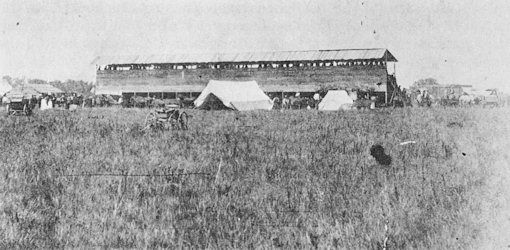
The caption below the same picture in Blackburn's Heart of the Promised Land photo reads differently: "The grandstand bleachers, shown above, collapsed on July 4, 1889, under a holiday crowd."
The same image appears yet a third time in Larry (Buddy) Johnson's essay, "Early Professional Baseball in Oklahoma City" at the Oklahoma City Metropolitan Library System's Images of Oklahoma series (after clicking the link, you may need to press your refresh key, F5, for the essay to appear). In that essay, when clicking on the thumbnail of the ballpark photo there, you will see that the photo's caption reads, "Territorial Fairgrounds Grandstand, north of Reno just east of Santa Fe Depot (c. 1889)." However, in the essay itself, Buddy says,
No one is sure when or where the first game of baseball was played in Oklahoma City, but in the summer of 1889, teams had formed up and enough citizens were eager to watch that two temporary grandstands were built for fans - one on the west side and one on the east. We also know that baseball was played at one of the first citywide celebrations - Independence Day, 1889. A permanent grandstand was built at the fairgrounds at NE 8 and Harrison in 1890.Whether a fairgrounds was located that far north of Reno and that far east of the Santa Fe tracks, I don't know -- see the 1894 and 1901 Sanborn map images which appear shortly in this article -- but shuffling these cards and looking closely at the available sources, I am confident that the above photo was the facility built at Stiles Park (which was located at NE 8th & Stiles) and that it was built in 1890. A different facility, the one which collapsed on July 4, 1889, was built earlier in the Territorial Fairgrounds just north of Reno and east of the Santa Fe railroad tracks. A photo from the Oklahoma Historical Society shows the temporary and hastily constructed facility which collapsed, killing at least one person and injuring many others, and it is shown below (the photo shown below is a xerox copy of the real photo and is quite poor in quality -- but it is good enough to see the difference between the two structures:
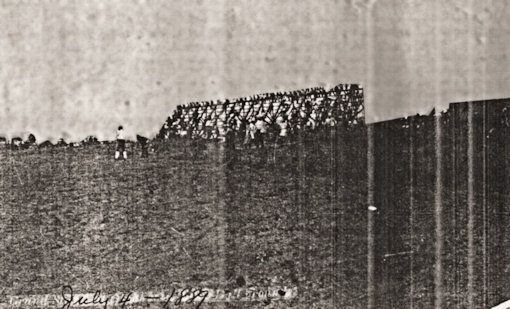
The OHS text for the above image reads, "Grand Stand at Oklahoma City Ball ground, July 4, 1889. The grandstand fell that day and one little girl was killed."
Pairing the images side by side, it is clear that two completely different structures are being referred to -- the July 4, 1889, facility that collapsed, and the 1890 facility which did not:
1889's Territorial Fair Grounds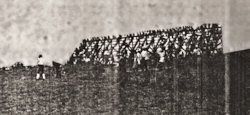 | 1890's Stiles Park |
1894 Sanborn Map | 1901 Sanborn Map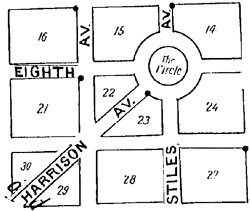 |

Buddy doesn't identify the photo's location but bleachers or grandstands can be observed in the background. This same picture appears in Terry L. Griffith's Oklahoma City: Land Run To Statehood (Arcadia Publishing 1999) where the photo's caption reads, "This photograph of a crowd at a baseball game on the grounds of the military reservation was taken during the summer of 1889," and that description sounds more like the Territorial fair grounds in the military reservation area north of Reno ... but could it have been the following?
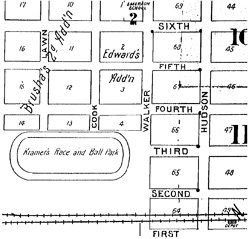 Kramer's Track & Ball Park. The 1901 Sanborn maps also show that a combined race track and ball park were located near downtown on the west side Walker between NW 2nd & NW 4th. The Oklahoman's on-line archives begin with September 1901 and they make no mention of this park. But, Oklahoman articles available before September 1901 do. A May 30, 1900, article notes that a baseball game played there between Oklahoma City and Tulsa "was an an easy victory for the home boys," the article noting that, "The attendance at the game was not very large, perhaps 300 people seeing it."
Kramer's Track & Ball Park. The 1901 Sanborn maps also show that a combined race track and ball park were located near downtown on the west side Walker between NW 2nd & NW 4th. The Oklahoman's on-line archives begin with September 1901 and they make no mention of this park. But, Oklahoman articles available before September 1901 do. A May 30, 1900, article notes that a baseball game played there between Oklahoma City and Tulsa "was an an easy victory for the home boys," the article noting that, "The attendance at the game was not very large, perhaps 300 people seeing it."Doubtless the most notable use of Kramer's Park was associated with the July 1900 reunion of Teddy Roosevelt's Rough Riders which was held in Oklahoma City. A June 10, 1900, article noted that the Rough Riders had contracted with Mr. L.F. Kramer, proprietor of Kramer's Park, for use of the facility during the reunion which brought thousands of Rough Riders, including Theodore Roosevelt, to the city. "All features of the reunion will be held there and a splendid place it will be for that purpose," the article said, it also noting that the seating capacity of the park was being expanded, "so that it will accommodate 6,000 more people than it will now hold."
Ball Parks Within the Colcord Park/Delmar Garden Area. Three different baseball facilities were located in Colcord Park/Delmar Garden area. The first was located within the 1902 racetrack oval; the second (1904) was a facility dedicated specifically to baseball located in the northwest area of Delmar Garden; and the third (1919) was located east of Exchange Avenue north of Tena (now SW 7th).
Colcord Ball Park. Colcord Park, as a general park, was dedicated to public recreation and amusement and was owned by Charles F. Colcord via his Colcord Park Corporation. In 1902, he sold an interest, probably a one-half interest, to investors in Kansas City (see Oklahoman, March 6, 1902), but that interest was acquired in 1903 by one Marre and John Sinopoulo in 1903 (see Oklahoman, April 11, 1903).
By all reports, Colcord Park, renamed Delmar Garden, was a 160-acre tract near Reno and Western although the precise boundaries of the park are not clear to me. That said, it seems likely that the location was the quarter section of property shown in the crop from the 1905 Greeley Township map which is shown below, highlighted in yellow. For reference, I've highlighted nearby Wheeler Park in green.

In the yellow highlighted area above, Reno is on the north, SW 15th is on the south, Western is on the east, and Blackwelder is on the west. Colcord Park was renamed to be Delmar Garden by 1902 although the part of it that we think of as "Delmar Garden" in the postcards and photos was a smaller part of the overall 160-acre park area. The park would come to be home to a baseball park, a race track, Delmar Garden entertainment area, mini-train rides and other amusements. Generally, see History of Oklahoma, Part I by Lewis B. Hill (Lewis Publishing Company 1908) at page 38.
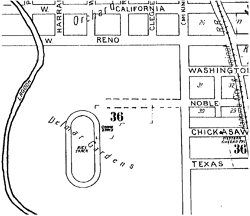 The 1st Sanborn map to show Delmar Garden was the 1904 version (created before March 30, 1904), shown at right. The 1902 ball park was located within the oval race track. See Oklahoman, May 10, 1902: "Within the oval of the race track a baseball ground is being prepared which is to be enclosed by a high board fence. The ball ground is to be completed prior to the opening game of the season in Oklahoma City which is scheduled for May 25." Oklahoma City teams played in this park between 1902 and 1904.
The 1st Sanborn map to show Delmar Garden was the 1904 version (created before March 30, 1904), shown at right. The 1902 ball park was located within the oval race track. See Oklahoman, May 10, 1902: "Within the oval of the race track a baseball ground is being prepared which is to be enclosed by a high board fence. The ball ground is to be completed prior to the opening game of the season in Oklahoma City which is scheduled for May 25." Oklahoma City teams played in this park between 1902 and 1904.Sportsman's Ball Park. The second facility, Sportsman's Ball Park, was a dedicated baseball park and it was located on the northwest part of Delmar Garden. Its grand opening occurred on July 4, 1904. See Oklahoman, June 29, 1904 and July 5, 1904.
The 1906 Sanborn map shows the location even if it crops off the west edge of the facility. As you can see below, it was slightly north and west of the Delmar Garden amusements area and, importantly, it was constructed on higher ground, the "oval" baseball diamond being under water from North Canadian River treachery in June 1904.
This was the city's first enclosed ball park. 800 seats west of the grand stand were added in 1907. See Oklahoman, February 7, 1907.
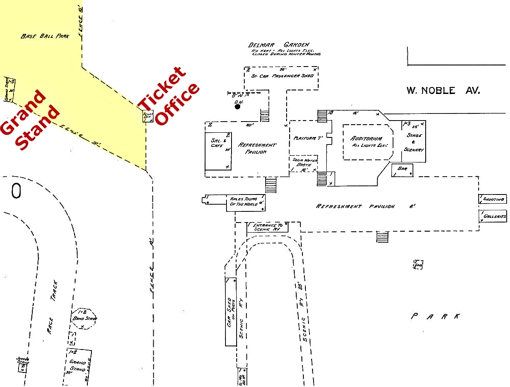
Exchange & Tena Ballpark. In 1919, a 3rd iteration of a Colcord/Delmar Park ball park was constructed, the all new Western League Park. Although Delmar Garden no longer existed as such, remnants of the overall park area were still available, and this new park was located east of Exchange and north of Tena (SW 7th). The 1922 Sanborn maps below show both the general and detailed location.
 | 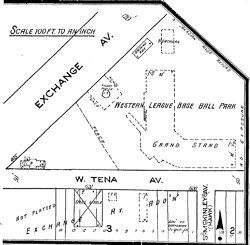 |

Detail from the article reads,
The grandstand will seat 5,000 persons and will take care of an overflow crowd of 6,500. There are 540 box seats and 1,000 seats in the reserved section in the center of the stand. Seats in the reserved section are of the chair type and when provided with cushions will be more comfortable than theater seats. * * * A clubhouse for players, bleachers and the new playing field help to make the park a really modern baseball plant. * * * The plant will cost approximately $35,000 when completely equipped. * * * Officers of the club, headed by President R.S. Randerson, who has been untiring in his efforts, share with more than three hundred stockholder-fans the credit for providing Oklahoma City with this splendid plant for Western league baseball here.For more information about the new park, see: Oklahoman, February 11, 1919; and Oklahoman, March 7, 1919.
Facilities in Colcord Park/Delmar Garden existed from 1904 until 1923 and, in addition to the original park's name, Sportsman's Ball Park, they had other names over their lifetimes: Saratoga Park (1915-1917), Liberty Park (1918-1919), and Western League Park (1919-1923).
Floods. The 1904 and 1919 parks were located on higher ground than the original park in the race track oval to avoid problems with North Canadian River flooding. However, as you will see in a 1923 photo which appears below, they were not nearly high enough. The new facility just described would likely have survived 1923 but for three words: North Canadian River. During May and June 1923, Oklahoma City experienced what was then described as the "worst flood in the city's history." Generally, see this part of my Trains II article for much more about the 1923 floods. In a nutshell, from May 28 through June 16 or so, that "worst flood" occurred and it wreaked havoc on the almost new Western League Park, so much so that at one point it appeared doubtful that play could be resumed there.
The aerial image below shows part of the flooded area and appeared on the Oklahoman's June 1923, front page ... notice the "Ball Park" marker, center right.

Against all odds and despite 30 inches of sand and silt covering the playing field and a gaping 15-foot hole in the outfield (among other problems), the park was ready to reopen, sans grass, on July 2, 1923, and the season was completed in the at least somewhat restored ball park after playing intervening games at the State Fairgrounds at NE 8th & Eastern (Martin Luther King Jr. Blvd. today). See Oklahoman, July 29, 1923. At the end of the season, a decision had not been made about playing there in the 1924 season, but hope, at least, existed that the investment made when the new field was built only four years earlier would not be in vain.
The above headline, "Will This Ever Again Happen To Oklahoma City?" was answered only 3-4 months later with a resounding, "Yes," and any such hope that the existing ball park could/would be saved was dashed. In October of the same year, a 2nd "worst flood" occurred and the damage this time was probably even worse. See Oklahoman, October 17, 1923:
Every stick and post of the centerfield, rightfield and leftfield fences are gone. The front wall is a wreck. It is believed that a new channel has been cut directly in front of the grandstand while deposits of silt and sand are expected to be several feet deep everywhere else. Judging by what happened in the June flood, sand will fill the grandstand to the third or front row of seats back of the boxes.I've not yet located a photograph showing what the ball park looked like before either 1923 flood, but the image below shows a photograph of the ball park after one of them (probably October):
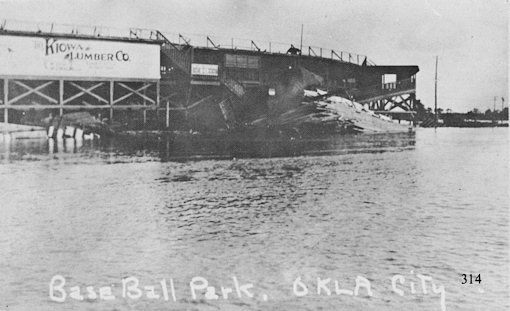
A totally new Western League Park was built at a different location and that will be described later in this article, but this ball park had come to its end.
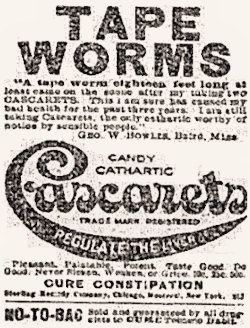 BASEBALL AT THE ABOVE PARKS: 1902 - 1904. This section describes a bit about the teams, players, and some stories about the various teams that played in Oklahoma City at the above early-day facilities. 1902 - 1904 will be traced rather closely than later years will be since those years present the struggle to create a sustainable professional baseball team in the city much more than years after 1904 do.
BASEBALL AT THE ABOVE PARKS: 1902 - 1904. This section describes a bit about the teams, players, and some stories about the various teams that played in Oklahoma City at the above early-day facilities. 1902 - 1904 will be traced rather closely than later years will be since those years present the struggle to create a sustainable professional baseball team in the city much more than years after 1904 do.Throughout this section, to assuage the occasional tedium, I'll include newspaper ads here and there which were contemporaneous with the year being discussed, just for fun. For example, the 1902 ad shown here shows how to solve your 18-foot tapeworm, constipation, bad breath, and other problems.

BASEBALL IN 1902. After a 1901 season with no Oklahoma City team, 1902 witnessed efforts to (1) form and field a professional team, (2) form a league in which it would play, and (3) secure a ball park facility to do so. How did we fare? Item (3) has already be answered affirmatively, above – Colcord Park contained a baseball field within the race track oval. The answer to (2) is that, while substantial efforts were made to form a league which consisted of teams from particular cities, none of the multiple attempts to do so in 1902 met with success. The answer to (1) depends upon the definition of the word "professional" – if it means that players and managers received compensation for playing and managing on at least a fairly consistent seasonal basis, we did have a professional team in 1902. If the existence of and participation in a league is part of the definition, we did not – but what does that make the Harlem Globetrotters? Answers will vary but mine is that we did have a professional team even though it was not a member of any league in 1902. As to player compensation, nothing akin to salaries or stipends are mentioned in any article but occasional articles speak of a game "purse" and gate receipts which would either be shared or paid to the winning team.
Those are the short answers. The longer answers to (1) and (2) take a good bit of telling, so here we go ...
Attempts To Form a Team and a League. Researching the Oklahoman's articles on these topics is rather like sitting on the cylinder part of a yo-yo in motion ... ↑↑ yes, it's definitely gonna happen ; ↓↓ but, then, it did not ... over and over and over and over ... The problem, of course, was that the Oklahoman was utterly and completely a "homer" in its reporting when it came to Oklahoma City, generally, and baseball fit that general pattern with hyperbole being reported as fact. Only when the research is all done can it be clearly observed just how much of the Oklahoman's reporting about one Oklahoma City thing or another was fact or was merely disguised optimism.
Speculation about the city's team and potential league formation began in October 1901 with the arrival of Frank Quigg, baseball player (pitcher) and promoter, and it may well be that Quigg was the catalyst for at least the attempts to form not only a team but a league which would play ball in 1902. Quigg, born in Atchison, Kansas, in 1873, had played professional baseball since 1891 (Joplin, Mo., Topeka, Kan., St. Joseph, Mo., Leavenworth, Kan., Memphis, Tenn., Denison, Tex., Little Rock, Ark., Auburn N.Y, Oklahoma City in 1900; and Enid in 1901). See Oklahoman, February 4, 1902.
In October 1901, the Oklahoman reported:
"I'll have all winter to work on the proposition this time," said Quigg to the reporter, "and you may depend upon it we'll have the game of ball played here next summer, and not bloomer ball, either. El Reno, Wichita, Shawnee, Arkansas City and Winfield will all have good clubs next year and there will be great games going on in these parts and Oklahoma City should have a finger in the pie."The "this time" part sounds like Quigg may have made a previous baseball effort here, but that is speculation. He obviously contemplated a league consisting of teams in Oklahoma and Kansas.
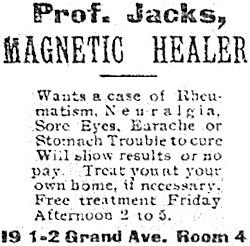 Optimism was reported again in the Oklahoman, December 8, 1901:
Optimism was reported again in the Oklahoman, December 8, 1901: There seems to be brighter prospects for base ball being in Oklahoma City next year than there was last year, and a team has already been signed by Manager Quigg, who has had the base ball business in hands. ¶ The mar_or [illegible] of forming a circuit has been taken up again with the cities of Wichita, Winfield, El Reno and other towns and there seems to be good reason to believe that everything will go along all right. * * * The new team which Manager Quigg has signed is made up of all good players. There is not one among them that is a lobster or a fresh stiff. They are all young blood and nearly all new faces. ¶ Two responsible citizens have made an offer of a field for the games and there is not likelihood of there not being a place where the games can be had. ¶ There will probably be a meeting of the managers of the different teams at this place for the purpose of agreeing on a salary limit and other matters.Were the team members already signed and were they "all good players?" If they were either signed or were good players, that does not match later stories which complained about too many amateurs being on the team and the need for better players.
By February 1902, it was reported that Quigg had pretty much put together the new team, to be called, "The Statehoods" (later 1902 articles also called the team the "Metropolitans") and the Oklahoman, February 4, identified 11 of the players and gave their previous baseball histories. Three players, James Bouldin, pitcher, Frank Quigg, pitcher and manager, and Ed White (also known as "the Deacon" and/or the "Mitten Marvel"), first base, had played on the Oklahoma City team in 1900, of course meaning that our city's professional baseball roots went back at least that far. "Manager Quigg has signed a team that will play first class ball," the article said. League teams mentioned as "being at the post when the bell rings" were Oklahoma City, Shawnee, Enid, and El Reno from Oklahoma and Arkansas City, Winfield and Wichita from Kansas.
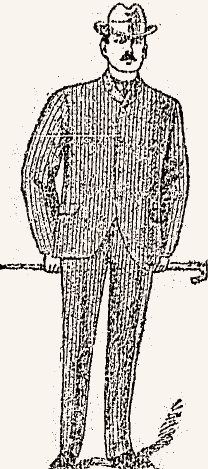 Bold statements were contained in the February 25th Oklahoman about the league and the season's schedule:
Bold statements were contained in the February 25th Oklahoman about the league and the season's schedule:A league meeting will be called just as soon as the El Reno proposition is concluded. The season will opened May 17, and is scheduled to close Sept. 17, giving sixteen weeks of the game in this section. The league will include teams at leading cities in the territory and Kansas and the occasional importation of some prominent club in the Western league for exhibition games. * * * There will be six games played every week during the season and there will be four games a week played at Oklahoma City, and of course there will be a game every Sunday, except an occasional game played at Shawnee and one or two other league points. * * * Every team in the league puts up a certified check for $100 guaranteeing that it will perform "i[t]s contracts."A March 5 article said, "Manager Quigg has received a letter from Howard Prince, at Enid, saying that the town will be ready to enter the Kansas-Oklahoma league when the time arrives."
By the end of March, the tune had changed and the "Kansas" part of the league's identification had been dropped. See Oklahoman, March 29:
Manager Frank Quigg, the local baseball magnate, returned yesterday from El Reno, where he has been for several days past in conference with representatives from Shawnee, El Reno, Chickasha and Lawton, relative to the extension of the Oklahoma League this season.
 No Oklahoman article mentions what happened to the Kansas league connection ... it just disappeared from the printed word. By mid-April, the league was identified as "a territorial league" and, that, in fact, it had been formed even though particular teams were not mentioned. See Oklahoman, April 17. But, in the same Oklahoman issue, another article said, "A number of prominent business men have taken the matter in hand at Patterson's cigar store this evening to perfect the organization of a local baseball company (a league), which will be capitalized at from $2,000 to $10,000." Stockholders were identified as Hugh McCredie, Fred Patterson, W.W. Storm, Juo. Carson, Taz Upshaw, C.F. Colcord, Geo. Gardner, F.H. Shelley, Jake Barnes, Harry Robare, S.C. Heyman, Jake Barnes, and Robrt Gailbreath. "The purpose of the organization is to establish permanently a first class minor league club in this city and to become a member of a strong territorial league." Others in the hoped-for league were identified as Shawnee, Lawton, Enid, Perry and Norman and possibly others.
No Oklahoman article mentions what happened to the Kansas league connection ... it just disappeared from the printed word. By mid-April, the league was identified as "a territorial league" and, that, in fact, it had been formed even though particular teams were not mentioned. See Oklahoman, April 17. But, in the same Oklahoman issue, another article said, "A number of prominent business men have taken the matter in hand at Patterson's cigar store this evening to perfect the organization of a local baseball company (a league), which will be capitalized at from $2,000 to $10,000." Stockholders were identified as Hugh McCredie, Fred Patterson, W.W. Storm, Juo. Carson, Taz Upshaw, C.F. Colcord, Geo. Gardner, F.H. Shelley, Jake Barnes, Harry Robare, S.C. Heyman, Jake Barnes, and Robrt Gailbreath. "The purpose of the organization is to establish permanently a first class minor league club in this city and to become a member of a strong territorial league." Others in the hoped-for league were identified as Shawnee, Lawton, Enid, Perry and Norman and possibly others. The stock company was later abandoned and some other arrangement was still being sought as late as the first week of May. See Oklahoman, May 6, which included the sub-headline, "League Is Assured." The article itself says, "The prospects for a good ball season are exceedingly bright. For some months past there was doubt about the circuit, but last week when Enid and El Reno circulated their petition for baseball maintenance all doubt was dispelled." [Emphasis supplied] If there had been such doubt, it certainly did not match the unhesitating optimism that earlier Oklahoman articles had expressed.
As well, and I don't know about you, but when I see "prospects" as being "exceedingly bright" combined with "all doubt being dispelled" in the same paragraph, I have to scratch my head a little, particularly since this article contains the first mention in the Oklahoman that the formation of a league had been considered to be uncertain. The article said that the opening game was "probably" May 16 in Shawnee with two other games immediately following, followed by three games in Oklahoma City, commencing May 25. Enid, El Reno, Shawnee, and Oklahoma City were the possible league teams mentioned.
The next day, an Oklahoman article said that, "Final arrangements for the new league team have now been concluded," which is to say, the Oklahoma City Statehoods, not the league itself. Officers of the local club were elected: S.C. Heyman, president; Harry Robare, secretary; and Byron D. Shear, treasurer; board members were identified as Hugh McCredie, C.F. Colcord, C.J. Bowman, E.L. Leach, and F.E. Patterson. Among other things, the organization assured that transportation and maintenance expenses of the team would be paid. The article did not mention how team players would be paid, however. See Oklahoman, May 7.
 1902 Games. Most often, games had a "call" time, e.g., 4:15 p.m., and games would abruptly end regardless of the innings played or what was going on when the call time occurred. As already said, Oklahoma City's 1902 home games were played in the baseball field which existed inside Colcord Park's race track oval. Sometimes game attendance was quite good, e.g., 4,000-5,000, but more often it was quite bad, e.g., 175-200. Transportation was a problem since the trolley lines did not extend to the park during 1902's baseball season and the cost of buggy taxi or hacker service was too high to warrant the expense -- remember that, at this time, Colcord Park/Delmar Garden was about a mile west of Oklahoma City proper and the automobile was not yet available to any but the wealthy and not all of them were sold on the then-novelty as a normal means of transportation. Horses, buggy, rail, and walking were the methods of transportation for most. For teams coming into the city, sometimes teams arrived late since they were dependent upon train schedules between the cities being punctually met. Despite the absence of a league and the problems mentioned, the Oklahoma City played games through May 19 through at least August 17. The last games I could locate which were scheduled were stated to be August 18, 19 and 20 against Enid and August 21, 22 and 23 against Shawnee, but they do not seem to have occurred – at least, the Oklahoman made no report of those games. For a little more about the August games, see below.
1902 Games. Most often, games had a "call" time, e.g., 4:15 p.m., and games would abruptly end regardless of the innings played or what was going on when the call time occurred. As already said, Oklahoma City's 1902 home games were played in the baseball field which existed inside Colcord Park's race track oval. Sometimes game attendance was quite good, e.g., 4,000-5,000, but more often it was quite bad, e.g., 175-200. Transportation was a problem since the trolley lines did not extend to the park during 1902's baseball season and the cost of buggy taxi or hacker service was too high to warrant the expense -- remember that, at this time, Colcord Park/Delmar Garden was about a mile west of Oklahoma City proper and the automobile was not yet available to any but the wealthy and not all of them were sold on the then-novelty as a normal means of transportation. Horses, buggy, rail, and walking were the methods of transportation for most. For teams coming into the city, sometimes teams arrived late since they were dependent upon train schedules between the cities being punctually met. Despite the absence of a league and the problems mentioned, the Oklahoma City played games through May 19 through at least August 17. The last games I could locate which were scheduled were stated to be August 18, 19 and 20 against Enid and August 21, 22 and 23 against Shawnee, but they do not seem to have occurred – at least, the Oklahoman made no report of those games. For a little more about the August games, see below. 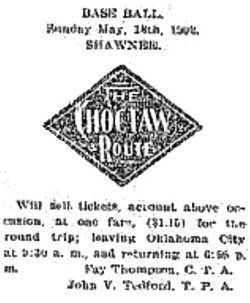 The Metropolitans' 1902 season began with three games in Shawnee, and they lost all three. Round trip train service was provided via the Choctaw railroad. The first game was on May 19 (2-8), the second on May 20 (5-7) but the Oklahoman did not carry a report on the third, presumably May 21 or 22. Finally, on May 25, the Metropolitans' home opener arrived. See Oklahoman, May 25. Work continued on the Colcord Park playing field until just hours before game time but it did get done. Although the then-named Metropolitan street railway planned for its trolley to reach the area (to west Main and Harrah avenue – see Oklahoman, May 10), that hadn't been done yet and so the Frisco railroad initially agreed to grant a roundtrip ten cent fair to the ball groud at 2:30, 3:00 and 3:15 on May 25, the Metropolitans' first home game – see Oklahoman, May 23 – but changed its mind for safety concerns – see Oklahoman, May 25.
The Metropolitans' 1902 season began with three games in Shawnee, and they lost all three. Round trip train service was provided via the Choctaw railroad. The first game was on May 19 (2-8), the second on May 20 (5-7) but the Oklahoman did not carry a report on the third, presumably May 21 or 22. Finally, on May 25, the Metropolitans' home opener arrived. See Oklahoman, May 25. Work continued on the Colcord Park playing field until just hours before game time but it did get done. Although the then-named Metropolitan street railway planned for its trolley to reach the area (to west Main and Harrah avenue – see Oklahoman, May 10), that hadn't been done yet and so the Frisco railroad initially agreed to grant a roundtrip ten cent fair to the ball groud at 2:30, 3:00 and 3:15 on May 25, the Metropolitans' first home game – see Oklahoman, May 23 – but changed its mind for safety concerns – see Oklahoman, May 25. 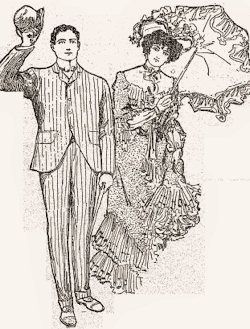 In any event, home opening game day finally arrived and Mayor C.G. Jones threw out the first pitch before a crowd of 5,000 there to see it. The Mets were shellacked 11-2 and the Oklahoman wasn't happy. See Oklahoman, May 27.
In any event, home opening game day finally arrived and Mayor C.G. Jones threw out the first pitch before a crowd of 5,000 there to see it. The Mets were shellacked 11-2 and the Oklahoman wasn't happy. See Oklahoman, May 27.Shawnee Has Made It Four Straight For the Statehoods – Team Needs New Material To Go Against Real Ball Players. Before five thousand spectators Sunday afternoon Quigg's white sox [ed note: I have no clue why the Oklahoman used the term "white sox" for some reason] gave a very poor imitation of the way baseball is played. The ground was not in good condition and the non-arrival of French and Wolfe [two newly recruited players], each of whom is enjoying a time on money sent them by the Oklahoma City club, weakened the team and was a sad disappointment both the players and the rooters.The next game, also reported in the May 27 article, was no different, except that far fewer were in attendance. The on-line graphics quality of the article is too poor to be certain, but only 306 or 506 or something like that were in attendance for game, Oklahoma City losing its 5th game in a row, 8-1. The 3rd scheduled home game with Shawnee was ostensibly canceled because of the weather, but it might just have easily been canceled for attendance and the level of play of the home boys. See Oklahoman, May 28:
Owing to the threatening weather yesterday, making a game improbable, the Shawnee base ball team returned home and the third game of the series of three to be played here was called off. There would have been a very poor attendance had the third game been played, for the public does not care to pay out good money to see games lost by two or three players who could not pass muster for admission to the high school cadet team. ¶ That the local team could have such players among its number was more a misfortune than a fault, as the club was organized rather late and was doubtful of organization at all until the eleventh hour. Also the management was unfortunate by reason of good players who had been signed and furnished transportation and expense money failing to come. * * * While Oklahoma City's start in baseball this season has been anything but brilliant, it may be set down as a certainty that management will not again allow such a poor exhibition of ball playing as was witnessed here Sunday and Monday.And, so, by late May, the Oklahoman's attitude about the about the team had turned from optimism to scorn, as seen above. A June 5 article's headline in announcing a 3-game road trip against Perry, Oklahoma, was, "Will Try Perry – Local Ball Aggregation Is Hunting For Something Easy – Want To Win A Game – And Are Going to, If they Have to Play Every Team in Oklahoma."
The team did do well against Perry and other teams leading up to the Oklahoman's June 28 article, and the Oklahoman's optimism was on the rebound. That article concludes,
Problem is, the Wichita games didn't happen and the 10,000 spectators didn't either. Instead of playing Wichita, the Mets played Ft. Sill in a 3-game series beginning July 4. In that game, Ft. Sill won 9-7 before a crowd of 2,000 which is not a bad crowd at all for the population of the city at that time. The 1900 federal census showed Oklahoma County's population to be 25,915 and Oklahoma City's to be 10,037. All but 37 of the city's 1900 population, men, women and children, or almost one-half of those who lived in the county, would have needed to be present at the game for the Oklahoman's hype to have come true. Compared to the newspaper's 10,000 attendance prediction, 2,000 in attendance (assuming the Oklahoman's report was accurate) sounds like 2,000 attendees was a dismal failure ... which it was not. The Mets won the second game 6-4 before an unstated crowd, according to a July 6 article. In it, the Oklahoman reverted to its hyperbole mode and said, "The management of the Oklahoma City team is after three new players, who if they are brought here, will unquestionably give Oklahoma City the strongest aggregation of ball players in the two territories. On Sunday, July 6, Oklahoma City won the third game 8-5 before a crowd of 2,000 and the Oklahoman was in its happy personality once again. See Oklahoman, July 8.Arrangements have been completed by which the Wichita ball club will cross bats with the Metropolitans in Oklahoma City on the Fourth of July. There were be two games on that date, one in the morning and the second in the afternoon. There will be at least 10,000 spectators at the afternoon game.
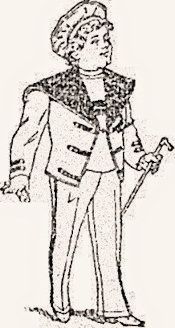 Games continued during July and August although the teams scheduled for the Mets continued to be unpredictable. An August 3 article reported that we lost to Pauls Valley and Wynnewood but won a game in Norman. We split a pair against Holdenville in mid-August. An August 13 article said that we would host a tournament around the first of September, a $250 purse being the prize, featuring the Mets, Shawnee, Enid and either Ft. Cobb or Blackwell, but no Oklahoman reports show that the tourney ever took place. An August 14 article said that we would play Enid on August 18, 19 and 20, and then Shawnee on August 21, 22, and 23, but no Oklahoman article reports on any such games and they most probably did not occur. The last game played by Oklahoma City in the 1902 season that I could find was a Sunday, August 17, game at Colcord Park against Pauls Valley. If it was the last game, the Statehoods/Metropolitans ended their season on a winning note, 11-2.
Games continued during July and August although the teams scheduled for the Mets continued to be unpredictable. An August 3 article reported that we lost to Pauls Valley and Wynnewood but won a game in Norman. We split a pair against Holdenville in mid-August. An August 13 article said that we would host a tournament around the first of September, a $250 purse being the prize, featuring the Mets, Shawnee, Enid and either Ft. Cobb or Blackwell, but no Oklahoman reports show that the tourney ever took place. An August 14 article said that we would play Enid on August 18, 19 and 20, and then Shawnee on August 21, 22, and 23, but no Oklahoman article reports on any such games and they most probably did not occur. The last game played by Oklahoma City in the 1902 season that I could find was a Sunday, August 17, game at Colcord Park against Pauls Valley. If it was the last game, the Statehoods/Metropolitans ended their season on a winning note, 11-2. Whatever may have become of all the various teams earlier mentioned that Oklahoma City with whom the Mets would join in becoming members of a league during the 1902 season, no Oklahoman article shows any of them as a member of any league. Although the Mets continued play in 1902 after its initial two series with Shawnee, above, e.g., with Shawnee, Chandler, Perry, Chickasha, Holdenville, Ft. Sill, Parsons, Kansas, Pauls Valley, Enid, Norman, Wynnewood, and probably others. As late as July 30, however, efforts were still being made to form a league, this one between Oklahoma City, Shawnee, El Reno, and Chickasha, and that if that happened the season might well extend into October. See Oklahoman, July 30. I found no articles indicating that the league ever came to exist and no games were played in October. Another article said that a tournament with a $250 purse was in the works for the 1st week of September in Colcord Park featuring Oklahoma City, Shawnee, Enid and Ft. Cobb or Blackwell. In its typical fashion, the article describing that possibility said, "The Mets have recuperated from their recent crippled condition and are now prepared to put up the finest article in ball playing ever seen in the territory." See Oklahoman, August 13. The Oklahoman contained no reports that the tourney in fact occurred and, in all probability, it did not.
Whatever may have become of all the various teams earlier mentioned that Oklahoma City with whom the Mets would join in becoming members of a league during the 1902 season, no Oklahoman article shows any of them as a member of any league. Although the Mets continued play in 1902 after its initial two series with Shawnee, above, e.g., with Shawnee, Chandler, Perry, Chickasha, Holdenville, Ft. Sill, Parsons, Kansas, Pauls Valley, Enid, Norman, Wynnewood, and probably others. As late as July 30, however, efforts were still being made to form a league, this one between Oklahoma City, Shawnee, El Reno, and Chickasha, and that if that happened the season might well extend into October. See Oklahoman, July 30. I found no articles indicating that the league ever came to exist and no games were played in October. Another article said that a tournament with a $250 purse was in the works for the 1st week of September in Colcord Park featuring Oklahoma City, Shawnee, Enid and Ft. Cobb or Blackwell. In its typical fashion, the article describing that possibility said, "The Mets have recuperated from their recent crippled condition and are now prepared to put up the finest article in ball playing ever seen in the territory." See Oklahoman, August 13. The Oklahoman contained no reports that the tourney in fact occurred and, in all probability, it did not.1902 Attendance. As far as fan support was concerned, after the first home game witnessed by 5,000, by the time games in late May and June rolled around, those articles which did report on attendance described it as "slim" or "poor." Actual numbers were not often stated, but a June 25 article described attendance as "probably not over two hundred," attributing the shortfall to the city's lack of transportation to the park. The article said that the problem would "probably have to be endured until the street railway gets into action." On July 4 and 6, at home against Ft. Sill, 2,000 or so were in attendance for each game. On Sunday, August 3, with a game against Shawnee scheduled to start at 3:15 or so, 2,000 were in attendance initially – but the Shawnee team did not arrive at Colcord Park until 6:30 -- probably because their train to the city did not arrive at its appointed time -- by which time those in attendance had dwindled to around 600. Those who stayed saw the Mets win, 7-1, their 1st extra-inning game of the season, an 11-inning affair. See Oklahoman, August 5.
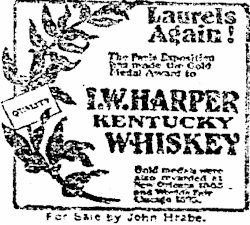 As for Frank Quigg, by June 6 he was suddenly and inexplicably gone from the scene. A brief June 5 article describing three upcoming games at Perry indicates that he was still around – "Quigg's warriors," the article called him. The next day, another brief article identifies a different manager, reading, "Manager of the locals has been to Texas for players. Bert McFadden, who has succeeded B.D. Shear as manager of the Oklahoma City baseball club, has been up in Texas several days looking up some ball players to strengthen his team." Where the heck did "B.D. Shear" slip in? If he is the same guy, one B.D. Shear was clerk of the District Court of Oklahoma County at the time. McFadden's name continued to appear in articles as the team's manager during the remainder of the rag-tag season. A June 12 article described the team, probably sarcastically, as an amateur team, even though players were getting something, though doubtless not much, for playing the game. Salaries, as such, are never described, but some articles mentioned divvying up a "game purse" and gate receipts, such as a June 28 article at Colcord Park against the Shawnee Blues in which the winning team would receive a $500 game purse and all gate receipts. The last mention of Frank Quigg in a 1902 Oklahoman article was in an August 21 article which reported that he was umpiring a game in Tombstone, Kansas. But, as will be seen, he would return to Oklahoma City.
As for Frank Quigg, by June 6 he was suddenly and inexplicably gone from the scene. A brief June 5 article describing three upcoming games at Perry indicates that he was still around – "Quigg's warriors," the article called him. The next day, another brief article identifies a different manager, reading, "Manager of the locals has been to Texas for players. Bert McFadden, who has succeeded B.D. Shear as manager of the Oklahoma City baseball club, has been up in Texas several days looking up some ball players to strengthen his team." Where the heck did "B.D. Shear" slip in? If he is the same guy, one B.D. Shear was clerk of the District Court of Oklahoma County at the time. McFadden's name continued to appear in articles as the team's manager during the remainder of the rag-tag season. A June 12 article described the team, probably sarcastically, as an amateur team, even though players were getting something, though doubtless not much, for playing the game. Salaries, as such, are never described, but some articles mentioned divvying up a "game purse" and gate receipts, such as a June 28 article at Colcord Park against the Shawnee Blues in which the winning team would receive a $500 game purse and all gate receipts. The last mention of Frank Quigg in a 1902 Oklahoman article was in an August 21 article which reported that he was umpiring a game in Tombstone, Kansas. But, as will be seen, he would return to Oklahoma City.As well as I'm able to determine, this is a wrap on the 1902 season. 1903 would bring a new hodgepodge set of facts of its own.

 BASEBALL IN 1903. Articles about Oklahoma City's 1903 team began appearing in December 18, 1902. The article said,
BASEBALL IN 1903. Articles about Oklahoma City's 1903 team began appearing in December 18, 1902. The article said,Keen gratification is felt in Dallas baseball circles over the announcement that Oklahoma City, the largest town in Oklahoma Territory, has joined the Texas League circuit, and that Ted Sullivan has taken the franchise and the management of the club. * * * ¶ There is a strong feeling in Dallas baseball circles that the Texas League should expand into an eight club circuit for the season in 1903. The following cities are preferred: Dallas, Fort Worth, Waco, Corsicana, Shreveport, Paris, Denison and Oklahoma City, with a good liking for Ardmore, I.T., in the event Denison should not be available.But, as it developed this was merely the beginning of the 1903 version of Oklahoma City's baseball yo-yo. Without any intervening mention in the Oklahoman, it's April 11 issue read differently:
Base Ball Sure
League Has Been Formed To Give Territory Professional Games
Season Opens May Third
League Will Be Organized at Enid on April 20 – Arkansas City and Winfield Will be Members of the Association
A movement has been underway the past two months to form a baseball league for Oklahoma. Yesterday positive assurances were received here that the league would be a go. Frank Quigg, who is the originator of the movement, told an Oklahoman reporter last night that all of the towns have got down to a business proposition – that is, they are willing to put up a certified check in the hands of the man to be selected as president of the league, at Enid, on the 20th inst., as a guarantee of their completion of their playing schedule. ¶ The league will be known as the Southwestern Association of Baseball clubs. The cities in the circuit will be Shawnee, Oklahoma City, Enid, Arkansas City and Winfield. ¶ Arkansas City and Winfield will support their team jointly, half of the games to be played in Arkansas City and the balance in Winfield. ¶ The salary limit of the league is to be $450 per month and board and room for the players. ¶ The season will commence on May 3 and conclude on September 27. ¶ The umpires are to receive $2.50 a game and transportation. ¶ Twenty-six games will be played a month – half at home and half abroad. ¶ At the league meeting to be held on the 20th a constitution and by-laws will be arranged and a playing ball and schedule adopted. ¶ Manager Quigg has completed his team and guarantees it to be the best that has ever represented Oklahoma City. * * * Lawton or Ft. Sill will be the attractions before the regular championship season opens. * * *
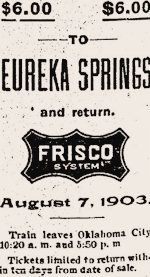 An April 15 article identified the players by name and described improvements to Colcord Park. Shawnee would be Oklahoma City's May 3rd first regular season game. At the April 20 meeting in Enid, the Southwestern League was formalized and (surprisingly) they were the same league teams identified in the April 11 article: Oklahoma City, Shawnee, Enid, and Arkansas City-Winfield. League officers were selected and "All of the clubs agreed to play under the national agreement," according to the April 21 Oklahoman. I'm not certain but I suppose that means the 1903 "national agreement" referred to at Baseball-Reference.com which was signed by the national association of minor league clubs which officially organized professional baseball under one comprehensive set of rules. Also, see the December 18 article, mentioned above, which mentions that organization. The April 21 article produced a schedule for the first half of the "championship season" which is to say, from May 3 through July 7.
An April 15 article identified the players by name and described improvements to Colcord Park. Shawnee would be Oklahoma City's May 3rd first regular season game. At the April 20 meeting in Enid, the Southwestern League was formalized and (surprisingly) they were the same league teams identified in the April 11 article: Oklahoma City, Shawnee, Enid, and Arkansas City-Winfield. League officers were selected and "All of the clubs agreed to play under the national agreement," according to the April 21 Oklahoman. I'm not certain but I suppose that means the 1903 "national agreement" referred to at Baseball-Reference.com which was signed by the national association of minor league clubs which officially organized professional baseball under one comprehensive set of rules. Also, see the December 18 article, mentioned above, which mentions that organization. The April 21 article produced a schedule for the first half of the "championship season" which is to say, from May 3 through July 7. Unfortunately, the league did not last that long. A May 13 article said,
All sorts of rumors are rife in the baseball world. At the meeting of the Southwestern league magnates in this city yesterday morning there was a stormy time, Manager Cook of Shawnee raising a rumpus because of the financial arrangements of the league. The league looks to be doomed.A May 16 article said that,
Shawnee and Oklahoma City are pulling in opposite directions, that much is certain, but as to the question as to whether Manager Quigg or Manager Cook will come out on top no answer can be given at present. A new league is even now in process of formation.
 The next day, Quigg was apparently alone in whatever position he was maintaining and either he or the others withdrew from the league and it ceased to exist. See Oklahoman, May 17 for more about the dispute and the development.
The next day, Quigg was apparently alone in whatever position he was maintaining and either he or the others withdrew from the league and it ceased to exist. See Oklahoman, May 17 for more about the dispute and the development.But ... oh ... I said something about 1903 being another yo-yo season didn't I. On May 19, an article indicated that the "row may be ended" and that a "peace conference" was to be held on May 23. However, before that meeting occurred, a May 21 article reported that Quigg severed his connection with the team and that unless "some one comes to its rescue it will be disbanded." The article quotes Quigg liberally and you can read it to learn more. The article concluded with the Oklahoman's take on where things stood about baseball continuing in 1903:
The fans certainly hope Oklahoma City will be given representation in a good league, but they will insist that the team be a good one. No more third and fourth rate comidnations [combinations?] need apply, is the verdict of fandom.A May 22 article reported that the team had disbanded and that its members were "leaving the city as rapidly as they can find positions elsewhere." But a May 24 article reported that the city "will have a team" and that we were not to be left out of a reorganized Southwestern league. The possibility of the Texas League from Paris, Texas, transferring here was mentioned, and that possibility was reinforced by a May 26 article which reported that the manager of the Paris team had laid out a proposition to the Shawnee, El Reno and Enid components of the possible new league which would accomplish just that. A May 27 article made that possibility sound as though it was a certainty. What wasn't certain was whether the Oklahoma City club would become a member of the Texas League (which Paris was) or whether it would be part of a revised Southwestern league. A May 29 article said that the Paris team was "surely coming" to Oklahoma City with a first game scheduled for June 7, and it said, "The other teams in the Texas league, of which Oklahoma City is now a member, are Corsicana, Dallas and Fort Worth ... and the Paris team was, at that point in time, leading the league. But — yo yo down time again — that didn't happen. A June 4 article reported that the "Paris deal is off," and that the team would not be transferred here. "[T]he citizens of Paris had raised an amount of money sufficient to keep the team there," the article said.
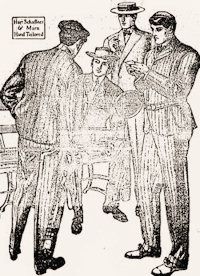 But, did we have a team for the remainder of the 1903 season? Sure — yo yo up — the Shawnee team transferred here, and it was the best of the lot in the original 1903 Southwestern league. See Oklahoman, June 6. Although a June 9 article indicated that a new league would be formed which might include six teams, but that didn't exactly happen — or, at least, if it did, the resulting league does not appear to have had a name or any structural league framework but was casually referred to as "the territorial league" (lower case letters) in a June 9 article. More realistically, the Metropolitans played out the remainder of their 1903 season as an independent team which sometimes and irregularly played games against Shawnee (most often — the team originally in Enid moved to Shawnee — see Oklahoman, June 9), Lawton, Chickasha, and other teams located in Oklahoma and Kansas. Although a June 14 article declared that the new league "opens today" against Lawton, and the article called the league the "Southwestern" league, if you search for any of the indicia of a league, e.g., a "Team Standings" item showing team names and win/loss records, you will not find it.
But, did we have a team for the remainder of the 1903 season? Sure — yo yo up — the Shawnee team transferred here, and it was the best of the lot in the original 1903 Southwestern league. See Oklahoman, June 6. Although a June 9 article indicated that a new league would be formed which might include six teams, but that didn't exactly happen — or, at least, if it did, the resulting league does not appear to have had a name or any structural league framework but was casually referred to as "the territorial league" (lower case letters) in a June 9 article. More realistically, the Metropolitans played out the remainder of their 1903 season as an independent team which sometimes and irregularly played games against Shawnee (most often — the team originally in Enid moved to Shawnee — see Oklahoman, June 9), Lawton, Chickasha, and other teams located in Oklahoma and Kansas. Although a June 14 article declared that the new league "opens today" against Lawton, and the article called the league the "Southwestern" league, if you search for any of the indicia of a league, e.g., a "Team Standings" item showing team names and win/loss records, you will not find it.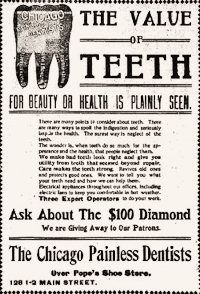 The 1903 Games. Despite the chaos, the Oklahoma City Metropolitans did play baseball from May 3 (actually, earlier than that if one counts pre-league opening games) until October 11 in 1903. After the Quigg period, the Mets proved that they had the teeth to be what the city wanted, but not until then.
The 1903 Games. Despite the chaos, the Oklahoma City Metropolitans did play baseball from May 3 (actually, earlier than that if one counts pre-league opening games) until October 11 in 1903. After the Quigg period, the Mets proved that they had the teeth to be what the city wanted, but not until then.During the Quigg period, the team played one or more games against Ft. Sill in April, but league play began Sunday, May 3, in Oklahoma City at Colcord Park. We were "slaughtered," 9-2, said a May 5 article, before a crowd of about 4,000. "There are doubtless a few men on the Oklahoma City team who know something about baseball, but they are very hard to find," said the article. "It is hardly necessary to say that the large crowd which saw the game was disgusted with the poor exhibition they gave of the national game." On Monday, the Mets again lost 9-2. A May 6 article said that Oklahoma City's 3rd defeat at the hands of Shawnee was "saved by the rain." Shawnee was ahead 6-0 when a hard rain prematurely concluded the game. "There is something radically wrong with the Oklahoma City team as at present constituted," said the article. "The men either cannot or will not play ball, and in either event the result is the same — the fans are disgusted." In his defense, Quigg said that the Oklahoman was "knocking" his team unjustly.
Mr. Quigg claims that in March he had as fine a bunch of players signed as ever put their signatures to Oklahoma City contracts, but that soon afterwards it appeared as if the league would not be formed and that therefore the men were allowed to go. Later, when the league was formed he had to begin all over his selection of a team, after the other managers had picked the men they wanted. It has been hard work, Mr. Quigg says, but before many days he promises to have a team in every way worthy of support. * * * The team and Mr. Quigg can rest assured that as soon as they begin to play good ball and to win a game now and then, they will receive the cordial and loyal support of the Daily Oklahoman — but Oklahoma City, which is accustomed to leading, doesn't take very gracefully to the idea of trailing along behind every baseball town in the territory.Finally, on May 9, the Mets won their 1st game, against Shawnee, who won the next day. As of May 10, Oklahoma City was in the cellar at 1-4. See Oklahoman, May 10. After 3 games against Arkansas City, the team was out of the cellar and was 3-6. See Oklahoman, May 12 and May 13.
After a 3-game series with Enid at Colcord Park, the Mets were approaching .500 at 5-6. See Oklahoman, May 14, May 15, and May 16. The league standings shown below were the last to be shown in the Oklahoman during the 1903 season. After this point, the league fell apart, described above, and no league standings would be shown during the remainder of the season for the Metropolitans.
By May 16, near the end of the Quigg period, the league standings were as follows:

After Quigg's departure and the transfer of the Shawnee team to Oklahoma City, two of the team's members became its managers, second baseman Pat Flaherty and Emmet Rogers, first base. See Oklahoman, June 6 and June 9. As for Quigg, it was reported that he had "gone to Wichita and is identified with the national game at that point." See Oklahoman, June 12. In fact, Quigg became the manager of the Wichita team and I'll have more to say about Mr. Quigg at the close of this 1903 section.
The first Oklahoma City game in the revised league was to be against Lawton. See Oklahoman, June 12 and June 14, and June 16. In its typical style, the June 14 article said that the game to be played later that day "will without doubt be the fastest and fiercest game ever played in this city," and this time the Oklahoman may have got it right. "Two thousand people on Sunday witnessed one of the finest exhibitions of the national game ever seen on the local diamond * * *. It required ten innings to decide the game, which was won by Oklahoma City by a score of 2 to 1." The Mets also won the next game on Monday, 6-1, before a small crowd. That was followed by four more June wins – another win against Lawton and four in a row against Shawnee. Since the Oklahoman did not report on other "league" members games (or, in fact, particularly identify them after June play began), I'm not able to say anything about that. When the Shawnee Blues came to town on June 28, the Mets were 7-0 under the new regime. "The fans of the city appreciate what Flaherty and Rogers have done for baseball here and will turn out en masse today to give tangible evidence of their appreciation," said a June 28 article. They did and the Mets won their 8th straight to make them 8-0. It took ten innings the next day (Monday) to hand the reborn team its first loss, 3-2. See Oklahoman, June 30.
Incidentally, whoever it was that was covering the Mets for the Oklahoman certainly had a flair for words and did a great play-by-play job in describing the action. Read the June 30 article for an excellent example. None of the Oklahoman's articles identify the writer, but my hunch is that many if not all of them were written by E.K. Gaylord himself – he was captain of the Oklahoman's own intercity team which defeated the Times-Journal newspaper team on July 8 by a score of 30-4 in a 7-inning game. See Oklahoman, July 9. For a fun read, in which the Oklahoman was clearly having a good time at the expense of its competition, read the full article.
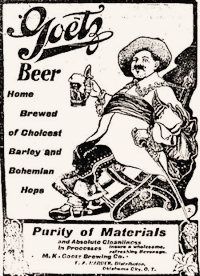 Back to the Mets. Another game was scheduled against Shawnee on June 30 but it was cancelled on game day because there were not enough fans present to justify playing. "The crowd present at the hour for beginning the game numbered less than 25, and, under the circumstances and in view of the fact that the wind and dust made baseball playing almost an impossibility," the game was postponed until the next week when Shawnee would return to play another series. Afternoon games during the week made it difficult to get away from work. "In the future it is probable that an effort will be made to have games that are to be played in Oklahoma City scheduled for Saturday, Sunday and Monday, instead of Sunday, Monday and Tuesday," the latter being theretofore typical. See Oklahoman, July 1. The article reported that it had been decided to allow ladies to sit in the grand stand "without extra charge," and that, "In some cities women are among the most enthusiastic fans and it is felt that there is no good reason why they should not be here also if given a little encouragement."
Back to the Mets. Another game was scheduled against Shawnee on June 30 but it was cancelled on game day because there were not enough fans present to justify playing. "The crowd present at the hour for beginning the game numbered less than 25, and, under the circumstances and in view of the fact that the wind and dust made baseball playing almost an impossibility," the game was postponed until the next week when Shawnee would return to play another series. Afternoon games during the week made it difficult to get away from work. "In the future it is probable that an effort will be made to have games that are to be played in Oklahoma City scheduled for Saturday, Sunday and Monday, instead of Sunday, Monday and Tuesday," the latter being theretofore typical. See Oklahoman, July 1. The article reported that it had been decided to allow ladies to sit in the grand stand "without extra charge," and that, "In some cities women are among the most enthusiastic fans and it is felt that there is no good reason why they should not be here also if given a little encouragement."The team left the city on July 3 to play a double-header in Shawnee on July 4 but a skimpy July 5 Oklahoman article only reported on one game being played, Shawnee winning 1-0, but the home boys beat Shawnee in Oklahoma City on Sunday, July 5, before 1,200 fans.
Notwithstanding all the hoopla about the rejuvenated league and the Metropolitans outstanding start in June, after July 5, a wholly different pattern emerged.
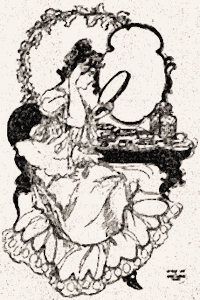 According to an article that will be mentioned shortly, the Mets were finding difficulty in scheduling solid competition within its natural territorial zone. Were more inviting opportunities to be found beyond the horizon north of the border, at Wichita? The July 8 Oklahoman reported that the Mets were off on a road trip to play former Met's manager Quigg's Wichita team and that no games would be played in Oklahoma City until Sunday (July 12) when the Mets would have a three-game series with Ft. Sill and a July 10 article reported that the Mets would host the Frisco's railroad St. Louis team "a week from Sunday", which would be July 19. The Ft. Sill games did not happen – instead, the Mets played at Wichita on Sunday July 12, winning 8-0. The Friday before that the Mets played a game, apparently in Wichita, against the Dold Packing company, winning 13-0, and on Saturday lost to Quigg's Wichita team 5-4 and were reported to play a game against Arkansas City, Kansas, on July 14. See Oklahoman, July 14. The announced game at Colcord Park against the St. Louis Frisco team, earlier set for July 19, did not happen, either. The July 17 Oklahoman reported that the team was "said to like Wichita" and might "remain there and play for a few weeks at least." "While the rumor has not been verified, it is generally credited because of the fact that, for one month at least, the team could not secure any very strong competitors for games to be played here," the article said.
According to an article that will be mentioned shortly, the Mets were finding difficulty in scheduling solid competition within its natural territorial zone. Were more inviting opportunities to be found beyond the horizon north of the border, at Wichita? The July 8 Oklahoman reported that the Mets were off on a road trip to play former Met's manager Quigg's Wichita team and that no games would be played in Oklahoma City until Sunday (July 12) when the Mets would have a three-game series with Ft. Sill and a July 10 article reported that the Mets would host the Frisco's railroad St. Louis team "a week from Sunday", which would be July 19. The Ft. Sill games did not happen – instead, the Mets played at Wichita on Sunday July 12, winning 8-0. The Friday before that the Mets played a game, apparently in Wichita, against the Dold Packing company, winning 13-0, and on Saturday lost to Quigg's Wichita team 5-4 and were reported to play a game against Arkansas City, Kansas, on July 14. See Oklahoman, July 14. The announced game at Colcord Park against the St. Louis Frisco team, earlier set for July 19, did not happen, either. The July 17 Oklahoman reported that the team was "said to like Wichita" and might "remain there and play for a few weeks at least." "While the rumor has not been verified, it is generally credited because of the fact that, for one month at least, the team could not secure any very strong competitors for games to be played here," the article said.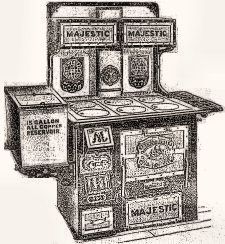 The team did return, though. A July 25 article reported that the Mets would play a Lawton-Ft. Sill club on July 26. Although a game was played at Colcord Park on July 26, it was against Purcell, instead, the Mets winning 8-2, according to a July 28 article. The same article said that games would occur here against Weatherford on Sunday, Monday, and Tuesday, August 2-4. The Sunday and Monday games did happen, the Mets winning both, but if the August 4 game was in fact played, the August 5 Oklahoman made no mention of it.
The team did return, though. A July 25 article reported that the Mets would play a Lawton-Ft. Sill club on July 26. Although a game was played at Colcord Park on July 26, it was against Purcell, instead, the Mets winning 8-2, according to a July 28 article. The same article said that games would occur here against Weatherford on Sunday, Monday, and Tuesday, August 2-4. The Sunday and Monday games did happen, the Mets winning both, but if the August 4 game was in fact played, the August 5 Oklahoman made no mention of it.After that, no games were reported to be played by the Mets until an August 11 article said that by would host Stillwater on August 16 and Anadarko on August 23, and, this time, the games were actually played and were preceded by considerable fanfare. See Oklahoman, August 15. The Anadarko team manager (also Sheriff of Caddo County) was bold enough to send the following telegram to the Mets' managers:
Messrs. Flaherty, and Rogers: Will play you Sunday, August 23, at Oklahoma City for a purse of four hundred dollars and the championship of the two territories. The "new country" will send six hundred people, three bands and the best ball team that ever donned an Oklahoma uniform. Our record is twelve of sixteen games played.Let's take these quasi-championship series of games one at a time.
The August 18 Oklahoman reported that the Mets won a 10-inning pitchers duel against "the champions of northern Oklahoma," Stillwater, 1-0, before 2,500 fans, it also noting that, "The Stillwater team did not remain to play the games advertised for Monday and today [Tuesday], thinking Sunday's close game sufficient glory, even though lost by them. Several of the players were employed for only one game and had to go home."
The result was the same for the Anadarko games on August 23 and 24, the Mets winning both. See Oklahoman, August 25. Anadarko was apparently fairly whipped up for the games and had dubbed itself as the "Champions of Oklahoma." The article reported that a special train would be arriving: "The Anadarko special came in with eleven coaches and several hundred people. Riding on the cow-catcher was a pennant of blue, which carried the inscription, 'Champions of Oklahoma, 1903,' though just how this pennant was discovered by Anadarko will probably always remain a mystery. A band came along to emphasize the claim, and altogether it appeared that the visitors were here to carry off that big purse and gate receipts." "Alas! for the vanity of frail humanity," the article said. 2,500 saw the home team win the first game 7-4 and the second 9-8. The Oklahoman sportswriter wasn't impressed with the play in either game:
While Sunday's game of baseball between the Oklahoma City and Anadarko teams was a poor play, yesterday was the farce following it, for both teams played like brewery nines that had received their rations in advance.As far as I could locate — and I looked through each Oklahoman issue day by day — the August 24 game was last game of the 1903 season — almost. The October 3 Oklahoman reported that the Kansas City Blues of the American Association would be in town to take on the Mets for a three-game series on October 10, 11, and 12, and the article said that the Mets were practicing daily in preparation of this event, probably the 1st of its magnitude in Oklahoma City. "All the railroads running into Oklahoma City have arranged remarkably low excursion rates for Sunday, October 11, on which date it is estimated that 15,000 people" will attend that game. Although the number was overly optimistic, the Saturday and Sunday games did come off. A disappointing crowd of only 500 saw the Saturday game (we lost 17-7) but the Sunday game was much better. In an errorless game, the home boys went down 5-1 before 6,352 fans, "the largest number of people ever assembled to witness a ball game in Oklahoma City." See Oklahoman, October 13. The game didn't run its full course, however, since a "call time" had been set for 4:15 and the game was called in the 9th inning with the Mets at bat. The Blues were blanked in five innings, so the locals did put up a good fight. The 3rd game, set for Monday didn't happen because heavy rain on Sunday rendered the baseball diamond unfit for play. All things considered, it was a great way to end a really quirky season and set a good tone for Oklahoma City's next season, one in which the city would finally see a full season of play in the minor leagues, more or less.
Postscript: What Ever Happened To Manager Frank Quigg? Some of Quigg's history you will have already read concerning the 1902 and 1903 Oklahoma City seasons -- he played an important role in attempts made in those years to establish minor league baseball in Oklahoma City. But and unfortunately, there's more to say.
Eventually, Quigg stopped playing and/or managing and got into umpiring. A July 5, 1906, Oklahoman article reported that he had been picked to go to Japan to umpire baseball there, the country having acquired an interest in the American past time as early as then. If that happened, he wasn't gone long since he was umpiring in the Texas League in 1909 (Oklahoma City being a league member at that time). A July 24 article reported that he narrowly escaped mobbing by angry fans at a game a couple of days earlier at Colcord Park and that he failed to appear at the July 23 game. "There was a rumor yesterday that a warrant, charging Quigg with disturbing the peace, had been sworn out, and that the umpire would be arrested as soon as he appeared on the ball grounds," the article said. A July 25 article said that he had again failed to appear for a game and that law enforcement officials were there to arrest him should he have made an appearance. An August 27 article said that Quigg had received notice from the president of the Texas League that his services would no longer be required.
But that wasn't the worst of it. On December 31, 1909, Quigg was shot dead while participating in an attempted bank robbery in eastern Oklahoma County. The January 1, 1910, Oklahoman reported at great length that Quigg was killed while being a member of a group which attempted to rob the State Bank of Harrah (for non-locals, that's a small town in eastern Oklahoma County) the day before. One of the would-be robbers, though, framed the others and informed officials of what was about to transpire for the purpose of reaping reward money in doing so. Acting as a decoy, he led the others into a trap set up by several state and federal law officers, each of whom were armed with shotguns and were waiting in ambush. During the attempted robbery, law officers made their presence known and demanded surrender but the robbers began to flee. Not heeding a warning to stop, the article reported that Quigg, while trying to escape, was shot in the back by one or more a shotgun blasts by the waiting officers. "Shotguns, all loaded with buckshot, were used by all the officers, and out of the 12 shots fired, 27 shot took effect. Fourteen shot took effect in Quigg's back, three in his arms, and one in his right chest."
Thus endeth the lesson and the career of Frank Quigg, one of those who was instrumental in getting baseball into Oklahoma City in 1902 and again in 1903.

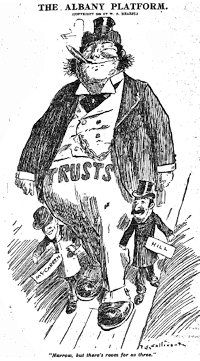 BASEBALL IN 1904. The yo-yo pattern I've previously described continued in 1904. During the season, league standings were set or reset to zero on there separate occasions and radically changed on another, the holder of one franchise (Shawnee-Chickasha-El Reno) would change several times, and one learns why the Enid team changed its name from the Evangelists to the Backsliders.
BASEBALL IN 1904. The yo-yo pattern I've previously described continued in 1904. During the season, league standings were set or reset to zero on there separate occasions and radically changed on another, the holder of one franchise (Shawnee-Chickasha-El Reno) would change several times, and one learns why the Enid team changed its name from the Evangelists to the Backsliders. Just for fun, since the Oklahoman ran so many of them in 1904, I'm peppering the 1904 season with political cartoons included on 1904 editorial pages which were copyrighted by William Randolph Hearst, newspaper magnate who was also a 1904 candidate for United States President on the Democrat ticket. It is remembered that, in this time, the Oklahoman was anti-big business and pro-labor in its political orientation. Locally, this translated into campaigns against Henry and Edward Overholser. At the national level, the Oklahoman published Heart's political cartoons on a regular basis. Click on small images for larger views.
I'd like to have been able to present photos of the players but, unfortunately, before and during 1904 the Oklahoman presented very few photographs in its newspapers. I did find one, however, toward the end of the season in the September 28 issue.
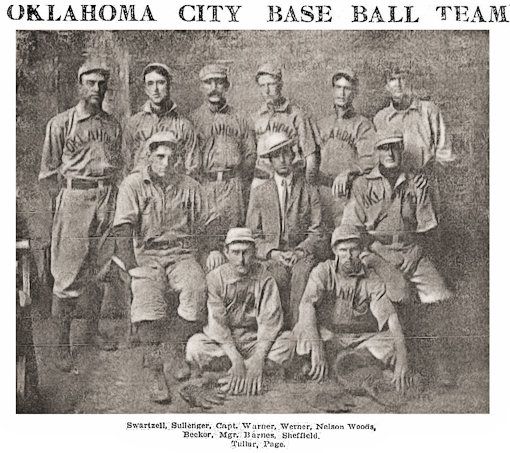
"Swartzell, Sullenger, Capt. Warner, Werner, Nelson, Woods,
Becker, Mgr. Barnes, Sheffield, Tullar, Page," reads the caption.
The photo appeared the morning of September 28, 1904 ... later that day, the Guthrie Senators defeated the Metropolitans in Guthrie 11-3 to clinch the Southwestern league pennant. League play ended on Sunday October 2 in Oklahoma City, the Mets winning the game 9-2 and all gate receipts and a $100 side purse. See Oklahoman, September 29 and October 4. Stewart, page 110, reported that the Mets won the 1904 Southwestern league pennant, but, according to the above contemporary Oklahoman reports, about that he was mistaken.
In Buddy Johnson's essay (press F5 after clicking the link if the article doesn't load), he says, "the first formal professional baseball team in the city was the Metropolitans (Mets) which played in the Southwestern League in 1904" and other on-line resources support that conclusion -- for example, see Baseball-Reference.com. In different words, both Stewart page 110 and Burke page 9 suggest, but don't exactly say, much the same thing. "Although professional baseball did not organize on a sustaining basis until 1904 ...," said Stewart, and "... but Oklahoma City's first professional baseball team to play in an organized league for a full season took the field in 1904," said Burke.
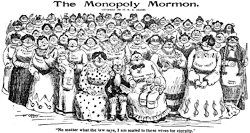 As you have already read, above, I peg the date of professional ball earlier than 1904, certainly by 1902 with a slight possibility of the year being 1900, and if what I've presented doesn't persuade you about that, that's OK ... there is room to differ.
As you have already read, above, I peg the date of professional ball earlier than 1904, certainly by 1902 with a slight possibility of the year being 1900, and if what I've presented doesn't persuade you about that, that's OK ... there is room to differ. But, did Oklahoma City play in an "organized league for a full season" in 1904, as Burke wrote? That observation makes for much chuckling (about the league being "organized"). None of those sources describe the chaos present during the 1904 season, of which there was an abundance -- and I'll do that here -- so let's get started.
SUMMARY OF THE 1904 LEAGUE. After the following snapshot, a lengthier summary of league play is presented, itself being followed by additional detail about the Sunday issue. Here's a snapshot of the season:
- Intended League Scope: A 6-team Kansas/Oklahoma league was attempted to be formed from November 1903 through mid-April 1904 but those efforts failed.
- Oklahoma Teams: Instead, the Southwestern league consisted of Oklahoma teams. Three of those, Oklahoma City, Guthrie, and Enid, were the constants (except that Enid's breaking of the schedule on July 1 caused its exclusion for a day or three -- see the "God Problem" problem, below).
- Problem With the 4th Team: The fourth leg of the Southwestern league was a constant problem. From April 26 - May 4, the member was Shawnee; from May 5 - June 21, it was Chickasha; from June 24- July 30 or so, it was Shawnee again; from July 30 until August 6 it was El Reno; from August 11 until the 1st week in September it was Shawnee again. After the Shawnee team folded again, the league played the remainder of the season through October 4 or so with only three teams.
- Crazy League Standings: League standings were set a zero or radically modified on four occasions: (1) May 1 when the season opened; (2) July 1 when Enid broke schedule because it refused to play on Sunday, July 3; (3) August 4 when various league disputes caused a major revision of win-loss records and league standings; (4) August 11 or 12 when Shawnee re-entered the league and standings were reset to zero. The Oklahoman did not report on what happened to league standings after the Shawnee team collapsed around the 1st week of September through the end of league play when the league only had three members.
- The Most Engaging Feature: Hands down, the most interesting feature had to do with the league's (and Oklahoma City's) handling of Blue Laws which prohibited "public sports" being played on Sundays. Oklahoma City's disregard for the same almost got the city a 2nd team during the season and probably would have but for the objection of the Southwestern league. Guthrie and Enid's handling of the issue could have, but did not, destroy the league.
- Pennant Winner: Guthrie. Guthrie clinched the league pennant in a victory against Oklahoma City on September 28.
| 1 | Teams Considered For League Membership November 1903 - April 1904 |
| From Kansas: Wichita, Emporia, Arkansas City, Salina, Hutchison & Newton From Arkansas: Ft. Smith From Oklahoma: Oklahoma City, Guthrie, Shawnee, El Reno, Chickasha, Enid, Muskogee, S. McAlester, Stillwater | |
| The Southwestern League was initially contemplated to be a six-city league composed of teams located in Kansas, Oklahoma, and perhaps Arkansas, including some combination of the cities mentioned above. Oklahoman articles ranging from November 18, 1903, through April 15, 1904, evidence those two intentions. | |
| 2 | League Members, April 26 - May 4 |
| Oklahoma City Metropolitans, Guthrie Senators, Enid Evangelists, Shawnee Browns | |
| League play opened May 1, Guthrie at Oklahoma City and Enid at Shawnee. Oklahoman, April 17. On the morning of May 5, league standings and records were: Oklahoma City 3-0; Enid 2-1; Shawnee 1-2; Guthrie 0-3. The Mets were scheduled to play the Shawnee team later in the day but IN Chickasha, which suggested a change. | |
| 3 | League Members, May 5 - June 21 |
| Oklahoma City Metropolitans, Guthrie Senators, Enid Evangelists, | |
| The May 6 Oklahoman reported a May 5 loss to the Chickasha Indians who replaced Shawnee in the reported league standings: Oklahoma City 3-1; Enid 3-1; Chickasha 2-2; Guthrie 0-4. So, team movement did not affect league standings. A June 14 article indicated that the Chickasha team would be moved to Shawnee. The Chickasha team folded and failed to appear in Oklahoma City for its scheduled June 21 game. | |
| 4 | League Members, June 24 - July 1 |
| Oklahoma City Metropolitans, Guthrie Senators, Enid Evangelists, | |
| The June 25 Oklahoman reported on a June 24 league meeting in which Shawnee's application for to replace Chickasha in the league was granted. Additionally, a schedule of games from June through August 21 was adopted. "With Enid in line to play Sunday ball and Shawnee in the league the association appears in good shape for the second half of the season," said the article. However, Enid failed to appear at the Friday July 1 game at Guthrie with other games scheduled there for July 2 and Sunday July 3, despite the agreed to schedule, and Enid was considered out of the league and possible replacement cities, particularly Ardmore, were being considered. | |
| 5 | League Members, July 1 - July 2 or July 3 |
| Oklahoma City Metropolitans, Guthrie Senators, | |
| The July 2 Oklahoman showed the league reduced to 3 teams with these begin-all-over standings as of July 1: Oklahoma City 1-0; Shawnee 0-1; Guthrie 0-0. A July 5 article indicated that the Enid team was "reorganizing" and would presumably be reinstated. | |
| 6 | League Members, July 2 or 3 - July 30 |
| Oklahoma City Metropolitans, Guthrie Senators, Enid Backsliders, Shawnee Browns | |
| A July 5 article indicated that the Enid team was "reorganizing" and would presumably be reinstated. It was, retroactively effective as of July 1. League standings were shown as follows as of the morning of July 4: Guthrie 4-0 (including 2 forfeits vs. Enid); Oklahoma City 2-2; Enid 1-3; and Shawnee 1-3. Enid's reinstatement occurred after Frantz lost his status to prevent Enid playing on Sundays and Enid played a Sunday game on July 10. The Enid team's name as "Backsliders" first appeared in a July 12 article but this was most likely the Oklahoman's attempt at sarcastic humor since Enid's adoption of that name was reported to occur a day later in a July 13 article, the same article reporting that Frantz had sold his interest to local citizens. A July 30 morning article showed standings to be: Oklahoma City 16-9; Guthrie 15-10; Enid 8-12; Shawnee 6-14. Oklahoma City had played 15 games in 18 days, the article said. Importantly, the article noted that Shawnee had withdrawn and that negotiations were underway for El Reno to take its place. The July 31 Oklahoman reported that the Mets beat Guthrie on July 30 to give them a 2-game lead in the league. Although no standings were shown, Oklahoma City's record at this point was 17-9. | |
| 7 | League Members, July 30 - August 6 |
| Oklahoma City Metropolitans, Guthrie Senators, Enid Backsliders, | |
| A July 30 article affirmed that El Reno had joined the league, taking Shawnee's place. But, what about the accumulated record in part 2 of the season – would it count? Initially, it did. August 2 and 3 articles showed the previous records and standings, the August 3 morning standings being Oklahoma City 18-10, Guthrie 15-12, Enid 10-12, El Reno 6-15. But, a league meeting on August 4 would change that. El Reno did not like the burden of assuming Shawnee's cellar standing and Oklahoma City had complaints about a certain player, Pokorney, who had played with Shawnee and Chickasha, playing for Guthrie. More, Guthrie complained severely about umpiring in some Oklahoma City games. League president Smith, from Guthrie, formerly the manager of the Guthrie team, threatened to have Oklahoma City put out of the league. Oklahoma City predictably got the short end, and, on August 5, the Oklahoman reported the new standings with various games being thrown out, as follows: Guthrie 10-5; Oklahoma City 9-8; Enid 7-9; El Reno 5-9. We wuz robbed! Oklahoma City's former 18-10 record evaporated with a click of Smith's fingers! | |
| 8 | League Members, August 6 - 11 |
| No league play after El Reno dropped out on August 6; a reconstituted league formed on August 12 | |
| After a week's play, the El Reno team folded, leaving the league with only three teams, and it was time to throw out league records once again. Possibilities about reconstituting the league were explored. | |
| 9 | League Members, August 11 - season end |
| Oklahoma City Metropolitans, Guthrie Senators, Enid Backsliders, and Shawnee Browns | |
| The August 12 Oklahoman reported that on August 11 Shawnee had again joined the league and that standings were: Enid 1-0; Guthrie 0-0; Shawnee 0-0; Oklahoma City 0-1. On August 14, the last league standing report shown in the Oklahoman during the 1904 season was this: Oklahoma City 1-1; Enid 1-1; Shawnee 0-0; Guthrie 0-0. Shawnee did not finish the season. The last Oklahoman article reporting on a "Shawnee" game was September 6, reporting on an Oklahoma City game vs. Holdenville/Shawnee. After that, the league continued without the 4th slot in the league being filled, and, as said above, no further league standings were shown in the Oklahoman. Since the Oklahoman did not report on all games during this period, it is difficult if not impossible to reconstruct the standings from the Oklahoman archives. Hence I'll just report on fact statements stated in the Oklahoman, as follows: September 28: After sweeping five games from Enid, "Guthrie is now ahead in the pennant race." September 29 (reporting on September 28 game): "Guthrie continued her winning streak today, defeating Oklahoma City 11 to 3. By winning this game Guthrie clinched the Southwestern league pennant." No further mention was made in the Oklahoman of the Southwestern league pennant during September or October. | |
If you want more detail than the above, I've put together a 9-page PDF file containing an abstract of the most significant Oklahoman articles. Click here to open and/or download that file to your computer.
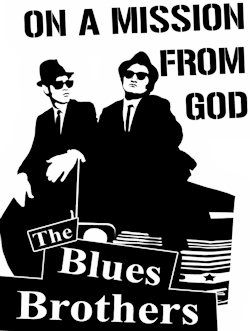 We're On A Mission From God — The Sabbath Problem. The greatest threat to the existence of baseball league play in 1904 (and earlier years, for that matter) was God — er, at least human laws and religiously conservative attitudes about doing much of anything on Sunday. Although mainly honored by being ignored in Oklahoma City as far as baseball was concerned, territorial statutes, adopted in 1890 from an existing state (in this instance, one of the Dakotas, I think), read like this:
We're On A Mission From God — The Sabbath Problem. The greatest threat to the existence of baseball league play in 1904 (and earlier years, for that matter) was God — er, at least human laws and religiously conservative attitudes about doing much of anything on Sunday. Although mainly honored by being ignored in Oklahoma City as far as baseball was concerned, territorial statutes, adopted in 1890 from an existing state (in this instance, one of the Dakotas, I think), read like this:Statutes 1890, Section 1886If you're particularly curious about how these statutes were applied in an instance not involving baseball, see this 1910 opinion of the Oklahoma Supreme Court: Twin Valley Tel. Co v. Mitchell, 1910 OK 368, 113 P. 914, 27 Okla. 388. Also, see A. Helm & Son v. Briley, 1906 OK 43, 87 P. 595, 17 Okla. 314.
The first day of the week being by very general consent set apart for rest and religious uses, the law forbids to be done on that day certain acts deemed useless and serious interruptions of the repose and religious liberty of the community.
Statutes 1890, Section 1887
Any violation of this prohibition is Sabbath breaking.
Statutes 1890, Section 1889
The following are acts forbidden to be done on the first day of the week, the doing of any of which is Sabbath breaking, 1st. Servile labor. 2nd. Public sports. 3rd. Trades, manufactures and mechanical employments. 4th. Public traffic. 5th. Serving process, unless authorized by law so to do. [Emphasis supplied]
Statutes 1890, Section 1890
Under the term "day" as employed in the phrase "first day of the week," in the seven sections following, is included all the time from midnight to midnight.
Statutes 1890, Section 1891
It is a sufficient defense in proceedings for servile labor on the first day of the week, to show that the accused uniformly keeps another day of the week as holy time, and does not labor upon that day, and that the labor complained of was done in such manner as not to interrupt or disturb other persons on observing the first day of the week as holy time.
Statutes 1890, Section 1892
All shooting, sporting, horse racing, gaming or other public sports, upon the first day of the week are prohibited. [Emphasis supplied]
Statutes 1890, Section 1893
All trades, manufactures and mechanical employments, upon the first day of the week, are prohibited.
Statutes 1890, Section 1894
All manner of public selling, or offering, or exposing for sale publicly, of any commodities, upon the first day of the week, is prohibited, except that meats, milk and fish may be sold at any time before nine o'clock in the morning, and except that food may be sold to be eaten upon the premises where sold, and drugs and medicines and surgical appliances may be sold at any time of the day.
Statutes 1890, Section 1895
All service of legal process of any description whatever, upon the first day of week, is prohibited, except in cases of breach of the peace, or apprehended breach of the peace, or when sued out for the apprehension of a person charged with crime, or except where such service shall be specifically authorized by law.
Statutes 1890, Section 1896
Every person guilty of Sabbath breaking is punishable by a fine of one dollar for each offense.
Oklahoma Territory was by no means unique in the above regards. These types of statutes were generally referred to as "Blue Laws," or "Sunday Closing Laws," and were almost if not completely universal in the United States, generally, with some states having more restrictive provisions than Oklahoma's. For example, notice that amusements, theatrical productions, dancing and the like, were not included in Oklahoma's territorial Blue Laws even though such kinds of things were prohibited in other states. As you can see from the 1904 Oklahoman ads below, various non-sports entertainment activities were openly promoted:
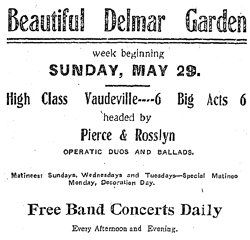 Amusements like these were commonly advertised. In a 1921 case, showing movies on Sunday was determined not to be a prohibited practice -- see Oklahoma v. Smith, 1921 OK CR 108, 198 P. 879, 19 Okl.Cr. 184, nor was a dance hall in 1929. See Oklahoma v Stout, 1929 OK CR 156, 276 P. 795, 43 Okl.Cr. 19. Sunday baseball games, being a public sporting event, were prohibited. Even so, such games were often announced with great fanfare, e.g., that special train excursions were bringing thousands of baseball enthusiasts into town on the particular Sunday game day. In 1913, the "public sports" part was modified to read, "All shooting, horse racing or gaming," hence giving a green light to baseball. | 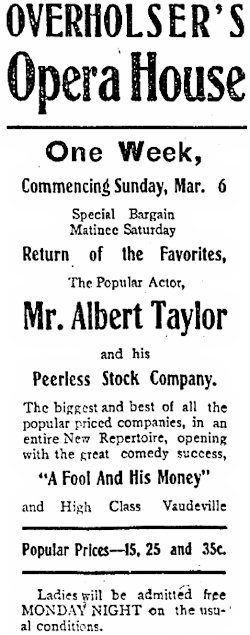 |
I also said, though, that these laws, at least concerning baseball, were not being enforced but were instead ignored, at least in Oklahoma City. It wasn't that these statutes were unknown — see this June 29, 1904, mini-editorial. But, if the Blue Law prohibitions about public sports, including baseball, were being ignored, what was the 1904 problem?
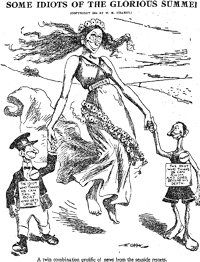 The Importance of Sunday. Before answering the above question, it is important to understand the importance of Sunday baseball in this time to the financial viability of a league and a team and its players, a part of their compensation being from gate receipts and, sometimes, bonus money for winning a particular game -- more likely than not on a Sunday, that day consistently resulting in the highest attendance compared to any other day of the week. Today, we are accustomed to the 40-hour work week with many not working on Saturdays or Sundays, as well on other holidays during the year which did not exist in 1904 -- that wasn't the way it was in this time. A typical employee's work-week was much greater than 40 hours and work often included Saturdays, as well. Moreover, games had to be played and over by mid-afternoon while most people were still at work -- night-lighted ball parks were yet to come. The one "protected" day that most everyone who wanted to do so could attend a game was only one one day of the week -- Sunday. Generally, see this web page operated by the Economic History Association for work-week information. For good reason, then, it was the Sunday baseball games that produced thousands of people in attendance whereas the weekday and even Saturday games often had crowds in the mid-to-low hundreds.
The Importance of Sunday. Before answering the above question, it is important to understand the importance of Sunday baseball in this time to the financial viability of a league and a team and its players, a part of their compensation being from gate receipts and, sometimes, bonus money for winning a particular game -- more likely than not on a Sunday, that day consistently resulting in the highest attendance compared to any other day of the week. Today, we are accustomed to the 40-hour work week with many not working on Saturdays or Sundays, as well on other holidays during the year which did not exist in 1904 -- that wasn't the way it was in this time. A typical employee's work-week was much greater than 40 hours and work often included Saturdays, as well. Moreover, games had to be played and over by mid-afternoon while most people were still at work -- night-lighted ball parks were yet to come. The one "protected" day that most everyone who wanted to do so could attend a game was only one one day of the week -- Sunday. Generally, see this web page operated by the Economic History Association for work-week information. For good reason, then, it was the Sunday baseball games that produced thousands of people in attendance whereas the weekday and even Saturday games often had crowds in the mid-to-low hundreds.Understand, also, that the 1904 Southwestern league, while a 4-legged stool most of the season, really relied upon three cities for its consistent support: Oklahoma City, Guthrie, and Enid. The 4th league member was almost too flaky to count on since it folded and changed hands so many times during the season and, in fact, did not exist at all after the first week in September. If Sunday games were not played in the three principal cities, the league could not likely survive. A protest, legal or otherwise, for baseball being played in Oklahoma City on Sundays, never appears to have raised its head. In fact, Oklahoma City would have likely gained a second team in 1904, Corsicana of the Texas league, due to the Sunday problem in Texas and not here, had the Southwestern league not protested that happening -- more about that shortly.
In Guthrie and Enid, it was different and Sunday challenges were presented. In Guthrie, the challenge came from the outside but in Enid the no-Sunday position was taken by the team's manager, himself.
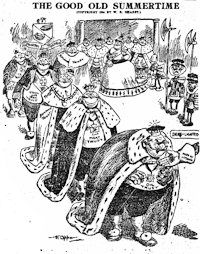 Guthrie. Guthrie was then the territorial capital and its team, the Guthrie Senators, always played baseball on Sundays -- but not without challenge. In July, a "Law and Order" association was formed in Guthrie, its object being to protest the playing of baseball in Guthrie on Sundays. M.T. Huribut [sp?], manager of the Western Union Telegraph company, was president, a Rev. Parker was vice president, and Jabez Brewer, owner of a printing shop, was secretary. On Sunday, July 17, it was reported that three prominent members of that association, likely the foregoing, sneaked onto the grounds of the Guthrie ballpark without paying admission fees, hid under trees, and watched the Guthrie game. "Their idea, as they themselves confessed in open meeting, was to find out who attended the game and have all parties arrested." The association proved unpopular in Guthrie and its association president resigned due to the protest of "business men and patrons of his office," and Sunday games in Guthrie continued to occur. See Oklahoman, July 21 and July 23. There would be no more Sunday-issue problems from Guthrie in 1904.
Guthrie. Guthrie was then the territorial capital and its team, the Guthrie Senators, always played baseball on Sundays -- but not without challenge. In July, a "Law and Order" association was formed in Guthrie, its object being to protest the playing of baseball in Guthrie on Sundays. M.T. Huribut [sp?], manager of the Western Union Telegraph company, was president, a Rev. Parker was vice president, and Jabez Brewer, owner of a printing shop, was secretary. On Sunday, July 17, it was reported that three prominent members of that association, likely the foregoing, sneaked onto the grounds of the Guthrie ballpark without paying admission fees, hid under trees, and watched the Guthrie game. "Their idea, as they themselves confessed in open meeting, was to find out who attended the game and have all parties arrested." The association proved unpopular in Guthrie and its association president resigned due to the protest of "business men and patrons of his office," and Sunday games in Guthrie continued to occur. See Oklahoman, July 21 and July 23. There would be no more Sunday-issue problems from Guthrie in 1904. Enid. Enid presented a different type of problem. Before the league formed, it appeared doubtful that Enid would even join the league, given the no-Sunday-ball position of Walter Frantz, manager and chief promoter of the Enid team. See Oklahoman, April 5, 1904. Part of that article reads,
Enid. Enid presented a different type of problem. Before the league formed, it appeared doubtful that Enid would even join the league, given the no-Sunday-ball position of Walter Frantz, manager and chief promoter of the Enid team. See Oklahoman, April 5, 1904. Part of that article reads,Chances of Enid having a team in the Southwestern Ball association are slim, in that the club is not in favor in Enid, on account of an absence of Sunday games. The management of the club and the chief promoter is Walter Frantz, who strenuously objects to playing ball on Sunday. * * * Here, as in other cities, the Sunday games are the best for drawing crowds. Local fans, those who follow the game throughout the entire season, are men who are employed six days out of the week, and a game of ball is their only recreation during the seven days. They want it to occur on Sunday. ¶ Frantz is a clever fellow, well liked by the citizens and an earnest worker in church circles. He has taught a little Sunday school class throughout the winter in the old postoffice building, and he is so strong in his convictions that his contract with the Blues at Kansas City, where he does a stunt [stint?] on the initial bag [1st base], read that he shall not be called on to play on the first day of the week.But, Enid did join the league and on April 17 it was reported that its opening game would be on Sunday, May 1, at Shawnee. I located no report of that game's outcome and whether it was actually played or not, or whether the Oklahoman's report was inaccurate, I do not know.
This is a fitting time to mention the Enid team's name. The May 1 Oklahoman reported that a local contest occurred in which nearly a thousand people submitted possible team names and that, on April 30, a committee selected the winner: the Evangelists. Two and one-half months later, that would change.
Other than on May 1, my review of the Oklahoman's archives reflected no other Sunday games played by Enid in the 1st part of the season, nor did that review reflect that any games scheduled for Enid games were not played.
 Except for the above, the Sunday problem wasn't discussed in the Oklahoman until the end of the first half of the season and league play went on without particular incident (other than the continuing problem of having a viable 4th league member), but the Sunday problem was simmering and about to come to a boil, even if it wasn't being reported on in the Oklahoman. Very often, the Oklahoman did not show league standings and the last league standing shown before July 2 was the June 12 standing report shown above. It is shown here so that you'll have something to compare standings with when you observe the July 2 standings report shown just a bit below.
Except for the above, the Sunday problem wasn't discussed in the Oklahoman until the end of the first half of the season and league play went on without particular incident (other than the continuing problem of having a viable 4th league member), but the Sunday problem was simmering and about to come to a boil, even if it wasn't being reported on in the Oklahoman. Very often, the Oklahoman did not show league standings and the last league standing shown before July 2 was the June 12 standing report shown above. It is shown here so that you'll have something to compare standings with when you observe the July 2 standings report shown just a bit below.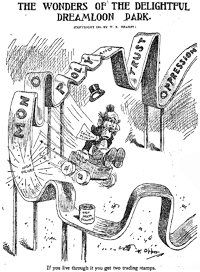 On June 24, the league's team representatives conducted a business meeting at the Oklahoma City Chamber of Commerce and arrived at the second half's schedule -- including Enid playing Sunday games, the first of which was scheduled for Guthrie on Sunday, July 3 and to be preceded by Friday and Saturday games at the same location. On Monday, July 4, Enid was scheduled to appear in Oklahoma City for the grand opening of the new Sportsman's Ball Park, to be followed by games on Tuesday and Wednesday. In its report of the meeting, the Oklahoman for the first time identified the hidden problem when it said, "With Enid in line to play Sunday ball and Shawnee in the league the association appears to be in good shape for the second half of the season." See Oklahoman, June 25.
On June 24, the league's team representatives conducted a business meeting at the Oklahoma City Chamber of Commerce and arrived at the second half's schedule -- including Enid playing Sunday games, the first of which was scheduled for Guthrie on Sunday, July 3 and to be preceded by Friday and Saturday games at the same location. On Monday, July 4, Enid was scheduled to appear in Oklahoma City for the grand opening of the new Sportsman's Ball Park, to be followed by games on Tuesday and Wednesday. In its report of the meeting, the Oklahoman for the first time identified the hidden problem when it said, "With Enid in line to play Sunday ball and Shawnee in the league the association appears to be in good shape for the second half of the season." See Oklahoman, June 25.Note: The "Shawnee" reference had to do with the fact that while Shawnee was an original member of the league, it had folded and Chickasha picked up its membership. However, Chickasha collapsed and failed to appear for its Oklahoma City game on June 21 (see Oklahoman, June 22), but at the June 27 meeting described below Shawnee again became the 4th member of the league. But, that's another topic ... back to the point.At the time, William J. Kimmel of Enid was league president and, according to a June 28 Oklahoman article, he was pleased over Enid's decision to play Sunday ball. The article reported that he said,
"There is no cleaner sport than baseball," said he, "and in opposing it well-meaning people do more harm than good. There is a large class of people who will attend ball games on Sunday who, having no other form of amusement, would otherwise spend the time in saloons. Baseball is even better than racing, as it will never be associated with organized gambling."Less than a week later, however, Enid failed to show up for its Friday July 1 game against Shawnee -- instead, it developed that Enid played ball in an exhibition game at Watonga on July 1 -- Enid's manager Frantz simply refused to playing ball on Sundays, regardless of what took place at the June 24 league meeting. The July 2 Oklahoman's headline read, "Another Schism," the sub-headline reading, "The Southwestern league now having trouble with Walter Frantz of Enid."
Guthrie, Okla., July 1 — Although the Enid team of the Southwestern league was represented at the Oklahoma City meeting when the new schedule was made out for July and August, yet manager Frantz of the Enid team yesterday refused to allow his team to play Sunday ball and instead of allowing the team to come to Guthrie to play the scheduled games of July 1, 2 and 3, he took the team to play exhibition games at Watonga, a small town in western Oklahoma, on July 1 and 2, thus breaking the league schedule.
 The president of the Guthrie team, Col. D.F. Smith (later to become league president), was furious and he announced that Guthrie would refuse to play Enid at any time in the future as long as Frantz was manager. The July 2 article said that Met's manager Barnes agreed with Smith's position, and the article presented the brand new league standings shown at right and Enid was apparently out of the league.
The president of the Guthrie team, Col. D.F. Smith (later to become league president), was furious and he announced that Guthrie would refuse to play Enid at any time in the future as long as Frantz was manager. The July 2 article said that Met's manager Barnes agreed with Smith's position, and the article presented the brand new league standings shown at right and Enid was apparently out of the league.Where did that leave Enid? The same article reported that:
It may be that the Enid team will remain in the league without Frantz, as the team members admit they cannot pay expenses without playing Sunday ball. Frantz is said to have stated that he would burn up the ball equipment and property at Enid before there should be a Sunday game played by his team. * * * ¶ Being disgusted at the actions of Walter Frantz, it is reported that President Kimmel has threatened to resign as chief official of the league unless Enid will play Sunday ball.
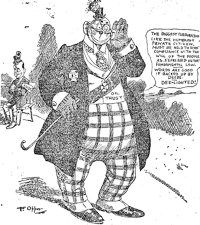 Shawnee, having been admitted to the league in place of Chickasha at the June 24 league meeting, hosted Oklahoma City on July 1 and, on that date, the first phase of the 1904 Southwestern league was done and the second had begun. By July 4, Enid was again shown in the standings and was apparently back in the league -- I say "apparently" since no Oklahoman article explicitly so states.
Shawnee, having been admitted to the league in place of Chickasha at the June 24 league meeting, hosted Oklahoma City on July 1 and, on that date, the first phase of the 1904 Southwestern league was done and the second had begun. By July 4, Enid was again shown in the standings and was apparently back in the league -- I say "apparently" since no Oklahoman article explicitly so states.But that fact wasn't known on July 2. With Enid out of the league, and with Oklahoma City's new ball park ready for its grand opening against Enid on July 4 but Enid now being out of the league, where did that leave Oklahoma City for its much ballyhooed July 4 game? The July 2 article indicated that Oklahoma City's July 4 game would not likely be with Enid under the circumstances but a July 3 article reported that, in fact, that Oklahoma City and Enid came to an understanding on July 2 that the game would be played as scheduled. That development caused league president Kimmel to resign. The article explained the convoluted situation, and I'll try to explain as simply as I'm able:
(1) Enid had already contracted to play in Oklahoma City on July 4, 5 and 6. (2) After Enid became a non-league member by not appearing in Guthrie on July 1, Oklahoma City nonetheless had the right to require that Enid, whether or not a league member, honor its contract to play here on those dates. (3) Oklahoma City's team manager Gene Barnes discussed the situation with league president Kimmel at a post-July 1 league meeting -- which would have had to occur on July 2 -- and, says Barnes, Kimmel said that was a matter "with which he had noting to do" and that gave Barnes the impression that the matter was between Enid and Oklahoma City; (4) Mr. Price appeared at that meeting on Enid's behalf and he and Barnes discussed the matter, Oklahoma City insisting that Enid keep its contract to play in Oklahoma City on July 4, 5 and 6. The article notes that Frantz has lost his rights to complain and that it was finally agreed that the previously scheduled Enid games would take place in Oklahoma City. (5) That development prompted Kimmel resigned, for two reasons: (a) The Frantz interest in the Enid team had not yet been bought out by others, and (b) apparently he did feel that he had something to do with July 4, 5 and 6 games since he said that Oklahoma City had demonstrated bad faith in demanding that Enid play in Oklahoma City on July 4, 5 and 6 "when arrangements had been perfected for that series to be played on the Enid diamond," although that does not appear to have been an accurate conclusion since the conclusion of Oklahoma City - Enid negotiations was that the games previously scheduled to be played in Oklahoma City would be played here. Kimmel said,"Integrity is the sole basis of organized baseball and it seems to be sadly lacking in this [Oklahoma City] organization." Reading through what I've just written several times, I'm not impressed with my ability to simplify the sequence of these fast-moving events.
Whoever (Barnes or Kimmel) was right or wrong about all of the above, Enid did play in Oklahoma City on July 4, 5 and 6 but when the July 2 deal was struck it wasn't understood that they would be league games, even though it developed that they were.
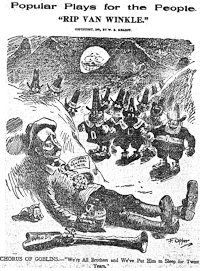 Frantz did not exit the Enid team immediately, but the team's captain, first baseman H. Price, attempted to make arrangements with Guthrie's president, Col. D.F. Smith, for the Sunday July 3 game to be played in Guthrie, as previously scheduled. By that time, Guthrie had already arranged for Ardmore to be present on July 2 and 3 so that couldn't happen. By Sunday July 10, Enid was playing Sunday ball again, it hosting Oklahoma City on that date. By July 12, Frantz sold his team interest to local citizens and the Sunday problem with Enid was done. See Oklahoman, July 9 and July 13.
Frantz did not exit the Enid team immediately, but the team's captain, first baseman H. Price, attempted to make arrangements with Guthrie's president, Col. D.F. Smith, for the Sunday July 3 game to be played in Guthrie, as previously scheduled. By that time, Guthrie had already arranged for Ardmore to be present on July 2 and 3 so that couldn't happen. By Sunday July 10, Enid was playing Sunday ball again, it hosting Oklahoma City on that date. By July 12, Frantz sold his team interest to local citizens and the Sunday problem with Enid was done. See Oklahoman, July 9 and July 13.So were the "Evangelists." The Oklahoman began referring to Enid as "the Backsliders" in a July 12 article which reported on a July 11 game. Apparently the name stuck since a July 13 article reported that, "Enid's ball team accepts the title of backsliders, and will in the future play on Sundays." Resigned league president William Kimmel became the Backslider's new manager, the article reported, and all was well with the league once again.
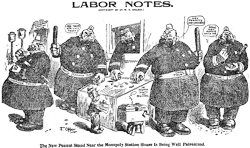 Oklahoma City. In something of the other side of the Sunday coin, Oklahoma City's implicit willingness to violate the territory's blue laws almost got Oklahoma City a second team in 1904. It seems that Texas, or at least Corsicana and Paris, took a different stance with regard to similar Blue Laws, and that those Texas league cities wanted to move to Oklahoma -- Corsicana to Oklahoma City and Paris to Ardmore. A June 23 Oklahoman article said that, "These changes are being caused by the taboohing of Sunday ball playing in the Texas towns." The article read as though it was a done deal for the Oklahoma City move, it reporting that the move had been approved at a Texas league meeting in Ft. Worth on June 22. The two Oklahoma moves would have had fine transportation since all Texas league cities would be located on the Santa Fe railroad line -- Dallas, Ft. Worth, Ardmore and Oklahoma City. Sixteen games were to be played in Oklahoma City beginning some time in the next week.
Oklahoma City. In something of the other side of the Sunday coin, Oklahoma City's implicit willingness to violate the territory's blue laws almost got Oklahoma City a second team in 1904. It seems that Texas, or at least Corsicana and Paris, took a different stance with regard to similar Blue Laws, and that those Texas league cities wanted to move to Oklahoma -- Corsicana to Oklahoma City and Paris to Ardmore. A June 23 Oklahoman article said that, "These changes are being caused by the taboohing of Sunday ball playing in the Texas towns." The article read as though it was a done deal for the Oklahoma City move, it reporting that the move had been approved at a Texas league meeting in Ft. Worth on June 22. The two Oklahoma moves would have had fine transportation since all Texas league cities would be located on the Santa Fe railroad line -- Dallas, Ft. Worth, Ardmore and Oklahoma City. Sixteen games were to be played in Oklahoma City beginning some time in the next week.But could Oklahoma City handle two teams at the same time, or, more importantly, could the Southwestern League tolerate a competing league in its own territory? The Southwestern league said, "No," at its June 24 meeting in Oklahoma City, and voted to send a telegram to the National Baseball association protesting the Texas league's Oklahoma City move to its own turf. See Oklahoman, June 25 and June 26.
The Southwestern league's protest concerning Oklahoma City was made good by the National Association of Baseball clubs and the move did not occur. See Oklahoman, June 28.
This ends my discussion of the 1904 season but you can read more detail in an abstract of the Oklahoman's articles relating to the 1904 season if you want. Click here to open and/or download that file to your computer.
This also brings to a close a review of the three critical years, 1902, 1903 and 1904, involved with the formation of professional baseball in Oklahoma City. One or more later baseball articles here will cover baseball from 1905 until the current time.














5 comments:
I'm really excited to see what you have on OKC baseball. It's an interesting subject for me.
Stay tuned, Jeremy, I hope that I won't let you down.
Especially timely given the changes to the Rangers team. Looking forward to it!
plaws
This is not a comment on you current post, rather, this is in response to your posting of Feb 06, 2009, regarding "that man stone". My grandfather was Grover M. Plew. While looking up information on my grandfather I noted your post some time ago. My mother was born in Oklahoma City, May 26, 1911. Therefore he would have been in OK at the time. Family history appears to know nothing of the moniker "that man stone" but as my grandparents were divorced in Alamosa County, CO in 1913, there was a lot we didn't know about my grandfather.
kevini, as I said in the article you mentioned, I have no doubt that Grover M. Plew was incorrectly identified as "That Man Stone" in/by Terry Griffith's book ... where he ever came up with that linkage, I don't know, but I've yet to find any support for it anywhere else. Griffith just made a mistake, as all authors do from time to time (me, too).
Post a Comment